“Across the globe, archaeology has been used to justify imperialism, the displacement of Native Americans and Indigenous peoples from their lands, scientific racism, ethnocentrism, and xenophobic nationalism. Its epistemology and research agendas have legitimized a racist teleology embedded in the notion that European whites exemplify progress and civilization.”
– Maria Franklin et al., ‘The Future is Now: Archaeology and the Eradication of Anti-Blackness’ in International Journal of Historical Archaeology 24, 753–766 (2020), p. 754.
“Academic discussions of first people in the lands we know today as the Americas continue to be framed in agnotology, defined as ‘how knowledge has not come to be’ and ‘how ignorance is produced through neglect, secrecy, suppression, destruction of documents, unquestioned tradition, and sociopolitical selectivity.’ Educational materials framed in agnotology support colonization of the mind, teaching people to think in ways acceptable to the nation-state and not to question so-called scientific authorities.”
– Paulette F. C. Steeves, The Indigenous Paleolithic of the Western Hemisphere (University of Nebraska Press, 2021) p. xix.
“Archaeologists are publicly positioned as experts whose scholarship is accepted as historic truth. Much like our power to shape language and naming, our power to shape historic narratives for racialized communities means that our work in the present contributes to the social construction of ahistorical essentialized ideas about race in the past and present, directly impacting communities to whom this history belongs.”
– Kelly Fong et al., ‘Race and Racism in Archaeologies of Chinese American Communities’ in Annual Review of Anthropology 51, 233-250 (2022), p. 239.
Note: emboldened characters in quotes in the article below have been added by the author for emphasis, unless stated otherwise.
The relationship between ‘race’ and ‘science’ in North American archaeology
‘Race’ is a social construct by which North American society, people and institutions are organised.1 ‘Race’ was constructed by white men in the eighteenth century, to build the myth of Black inferiority, in defence of slavery.2 In the nineteenth to twentieth centuries, anthropologists brought ‘race’ into the realm of ‘materialist’ or ‘western’ science with eugenics.
Eugenics developed symbiotically with physical anthropology, the study of human remains. In the late nineteenth and early twentieth centuries, North American physical anthropologists like Aleš Hrdlička, Madison Grant and Earnest Hooten abused the remains of Indigenous Americans and other ‘races’ in attempts to prove them biologically inferior.3
The backlash of some anthropologists and archaeologists to the Native American Graves Protection and Repatriation Act (NAGPRA) of 1990, which facilitates the attribution and return of appropriated and abused ancestral remains and belongings to Indigenous nations, has led such abuse to persist into the present day.4
The theory, methods and practice of archaeology grew out of physical anthropology to tell the story of ancient America according to White people who settled in the Americas as a result of colonialism (aka ‘White Settlers’), whose subjects were BIPOC (Black, Indigenous, People of Colour) individuals, cultures and communities that they had assumed control of.
Eugenics or scientific racism, or the study of communities or individuals as racial ‘subjects’ is by definition fake science, or ‘pseudoscience’. And since the discipline of archaeology is generally based on the scientific method, racist archaeology is by definition ‘fake archaeology’ or ‘pseudoarchaeology’, or archaeology that seeks to study individuals and communities involved in the archaeological process as subjects, rather than as co-authors or collaborators. A ‘pseudoarchaeologist’ is, therefore, a trained archaeologist who assumes epistemological sovereignty over other individuals, communities, cultures and their sources or history, in the process denying the autonomy and humanity of their subjects.
Though the myth of white superiority is generally no longer accepted in archaeological literature, this article demonstrates how the discipline of archaeology is still demographically, methodologically and historiographically structured according to notions of White Settler superiority.
White Settler superiority continues to disadvantage, disincentivise and harm non-White groups, both inside and outside of the archaeological community.
Archaeology is one of the whitest institutions in North America whose senior leadership is projected to become even whiter in the coming years.5 The most prestigious archaeology journals are set to remain dominated by White people, who will continue to produce the most commonly read and cited work, in the most prestigious journals.6 In archaeology, it is essential to be published in the prestigious and oft-cited journals to be hired, promoted, funded or gain tenure.7 And the institution’s single solution to its racial diversity problem – awarding scholarships to underrepresented groups – has been shown by antiracist scholars to further increase White superiority and inequality in archaeology.8
As antiracist White Settler archaeologist Laura Heath-Stout says in ‘Who Writes about Archaeology?’:9
…The more prestigious a journal is, the more dominated by straight, white, cisgender men authors it is likely to be. This suggests that…the power to influence archaeological knowledge production continues to be in the hands of the most privileged (male, cisgender, straight, and/or white) researchers.10
With respect to the writing of our past, the problem – expressed again here by Heath-Stout, this time as part of her 2019 PhD dissertation, ‘Diversity, Identity and Oppression in the Production of Archaeological Knowledge’ – is that:
The questions each scholar asks of the archaeological record are shaped by their particular identities and experiences, and their opportunities to pursue those research questions, in part because of differential access to the good mentorship and professional networks that furnish these opportunities. Our limited diversity leads us to overlook many fruitful avenues of research, and limits our understandings of systems of oppression and marginalized communities in the past.11
Antiracist archaeology is not only about advocating for the rights and equitable treatment of BIPOC groups in archaeology, but also about opening our minds to greater, multiple, more representative understandings of our past.
This article posits the institution of archaeology in its current state as ‘White Archaeology’, which is – until revolutionised, or in the words of Black antiracist archaeologists Ayana Omilade Flewellen et al., “dismantled” and “rebuilt from the ground up” – aligned with what western society calls ‘the scientific method’.12 White Archaeology and its proponents tend to describe this alignment as ‘true’, ‘real’, or ‘objective’ science, which seeks to continue study of BIPOC cultures, individuals and communities as archaeological subjects rather than epistemological sovereigns, co-authors and collaborators.13
The institution of White Archaeology and its proponents explicitly or implicitly consign BIPOC (namely Indigenous) archaeological-scientific methods to the realm of ‘religion’ or ‘imagination’, by describing them as ‘creationism’ or ‘unreliable’ in relation to their understanding of science, which is ‘materialist’ science.14 In refusing to acknowledge the epistemological sovereignty of BIPOC people, whose history White Archaeology has appropriated and assumed control of over centuries, our understanding of the past is, however, severely limited.
Suffice it to say, materialist science is a framework for understanding reality, not the framework, and a claim to objectivity falls flat on its face in view of other scientific perspectives.15 To claim scientific or archaeological objectivity is to repeat a racist trope used by White Archaeology advocates to, in the words of Sara L. Gonzalez, Associate Professor of Archaeology at the University of Washington, “deny Indigenous humanity”:16
This article demonstrates how the institution of White Archaeology, until revolutionised, encourages racist behaviour among archaeologists and archaeological organisations, who in turn advocate for racist and unrepresentative interpretations and systems of ancient American history and archaeology:

In committing to Tribal sovereignty, Dr Sara L. Gonzalez has been accused of not being a ‘real’ scientist or archaeologist. Taken from Twitter, December 14th 2022.
Where traditional systems of archaeology exist, racism and pseudoarchaeology persist, on autopilot.
This article based on recent publications by and opinions of antiracist North American archaeologists seeks to elevate antiracist perspectives across four North American groups: the Indigenous American community, the Black American community, the Chinese American community, and the White Settler American community.
Experiences of racism are neither limited to these groups of North Americans, nor are North American antiracist archaeologists limited by such arrangement; it is how their literature tends to be organised.
Antiracist archaeologists are united by a common goal, which is to dismantle the racism that pervades archaeology and intersects with other forms of discrimination.
Antiracism in North American archaeology
As Black archaeologist Whitney Battle-Baptiste tweeted in response to the race uprisings that swept across North America in 2020:
The future of archaeology is antiracist or it is nothing.17
Indeed, if White Archaeology is to transition to archaeology, it must commit to implementing an antiracist present and future led by antiracist archaeologists and activists.
The antiracist perspective is clear: where racism is not being acknowledged, confronted and actively dismantled in North American society and by its people, it pervades.18 And where North American archaeologists have not held themselves accountable for racism by acknowledging, confronting and actively dismantling their racism and the racist system that they contribute to, they are oppressing their BIPOC peers. As Black North American antiracist archaeologists Ayana Omilade Flewellen et al. explain:
The work of creating an antiracist foundation in the discipline is breaking from the norm: it is a break from an oppressive system that was built to advance the histories, ideas, and careers of a privileged few. Being an accomplice means placing oneself in a position that indisputably communicates a stance on advocating alongside BIPOC groups, fully complicit in the struggle toward equality. This complicity comes in the form of placing one’s privilege, body, career, and future on the line, all for the advancement and equitable treatment of those who have been historically oppressed.19
North American archaeologists who are not actively advocating alongside BIPOC groups and are not putting their privilege, body, career and future on the line to advance BIPOC treatment and rights in archaeology are not antiracist accomplices, and are therefore implicitly racist:
To achieve an equitable, antiracist archaeology, the foundation has to be built alongside accomplices, not allies. There is a profound difference between an ally and an accomplice. An ally is a person who works in partnership with marginalized groups to help change the system that challenges marginalized groups’ basic rights. This definition is based on the assertion that an ally, as a member of the privileged group, has the ability (when that individual chooses to exercise it) to assist in achieving equity for those who are subjugated. This concept of allyship positions allies as “Saviors”. Allies, however, are not helping to change a system. Instead, they are using it to position themselves as undercover agents of the system from which their power flows.20
Antiracist allies can declare support for the movement and take no active steps toward transforming their discipline. These archaeologists are being called on to practise self-awareness to confront their implicit racism, and become antiracist accomplices. As Chinese antiracist archaeologists Kelly Fong et al. write in their piece, ‘Race and Racism in Archaeologies of Chinese American Communities’:
Archaeologists in positions of power need to acknowledge inequities present in the structures of our discipline and commit to practising self-reflection, employing active listening, and taking concrete steps toward disciplinary transformation.21
Collaboration is one of the antiracist interventions that redistribute archaeologists’ narrative power. True collaboration moves beyond giving voice to the voiceless by centering community memory and action.22
Before we can build antiracist archaeologies, archaeologists must recognize the role of race in the development and operation of our discipline, including how racist structures prevent BIPOC archaeologists from entering and staying in the field. Archaeologists must also be reflexive about the ways in which archaeologists themselves often unintentionally produce and reproduce essentializing racial discourses.23
Antiracism begins with self awareness
Overall, the antiracist perspective outlines three steps that every North American archaeologist and archaeological institution must take to detoxify themselves of racism:
-
They must become self-aware, by acknowledging their own inevitable implicit or explicit racism. This means acknowledging that the commonly accepted view of the past has been written by White Archaeology, and to claim that the past has already been written is to propagate pseudoarchaeology.
-
They must actively listen to and support antiracist leaders and BIPOC groups, and make doing so a priority over taking advantage of their white privilege (i.e. by furthering their careers, life situations and personal agendas).
-
They must actively work with antiracist leaders and BIPOC groups to dismantle racist systems and processes, to transform the institution of archaeology. This means putting their careers and privilege on the line for the rights, equitable treatment and epistemological sovereignty of BIPOC groups, to facilitate the transition from White Archaeology to archaeology.
In the case of one of the largest archaeological institutions of the Americas, the Society for American Archaeology (SAA), awareness of racism began just two years ago, in March 2021. In its publication on archaeological ethics, the SAA admits to not including race or racism in its principles:
Three respondents noted surprise at the absence of mention of racial harassment and discrimination in Principle No. 9 on Safe Educational and Workplace Environments. The principle currently lists sex, gender identity, sexual orientation, ethnicity, disability, national origin, religion, or marital status. We speculate that “Race” may have been avoided here by the original authors of this principle in favor of “Ethnicity” as a more anthropologically precise term to reference issues that typically intersect with racial discrimination.24
Indeed, the term ‘ethnicity’ has been used by institutions and individuals to describe groups without acknowledging or confronting the racist systems by which society operates. As noted by Flewellen et al. in the context of antiracist archaeology, the social construct ‘race’ has been used (or not used) to deny or side-line the blatant racism that BIPOC archaeologists have faced since the field began to diversify.25
In 1994, according to data collected by the SAA about its membership, 98% of members identified as ‘European American’, with ‘Latin American’ individuals making up most of the remaining 2%.26 A mere 1-2 ‘Black American’ and 0 ‘Native American’ members responded to the survey.27 Though, by 2010, the number of ‘non-Hispanic white’ SAA members seems to have increased by 14%,28 data by Zippia indicates that there might have been fewer Black archaeologists in North America in 2019 (7.13%) than there were in 2010 (11.31%).29
That’s right – the number of Black North American archaeologists seems to have decreased by 4.18% within that nine year period. And Native American archaeologists seem to have increased in number from 0 in 1994 to just 1.2% of the demographic composition of North American archaeology in 2019 – an increase of around 1% in a twenty five year period.30
This data compiled by the SAA and data science specialists Zippia, though merely indicative, says a lot about the past and present racial (un)diversity of North American archaeology. It begs the question:
Why are there so few Black and Native American archaeologists? And how might the number of Black archaeologists in North America have decreased between 2010 and 2019?
North American archaeology is White Archaeology
“Archaeologists are probably the whitest people I know.” – Doug Rocks-Macqueen, 2013.31
In the words of Black antiracist archaeologist and activist Bill White in 2015:
‘While the archaeology of race has been an increasingly popular topic since 1980, the number of archaeologists of color has changed very little. The field of archaeology is overwhelmingly hyper-white*. Membership of the two major U.S Archaeology professional organizations – the Society for Historical Archaeology and the Society for American Archaeology – is over 95% white. This is not news.’32 *[Text strikethrough in the original]
Regrettably, it looks as though the SAA – from whom the most accurate (though limited) demographic data comes – is projected, in the coming years, in one way to remain as white, and in another way, become even whiter.33 In 2012, the SAA warned that:
Absent significant new recruitment, 10 years from now, the membership of the Society will probably still be predominantly white, with even higher proportions of this ethnic group among its senior leadership. Viewed in the context of the 2010 demographic profile for U.S K12 students, the disparity between SAA membership and societal composition may become more* pronounced in two decades.34 *[italics in the original]
What, you may wonder, is North American archaeology doing to combat its hyper-whiteness?
The answer is simply: scholarships.
As of the beginning of 2023, the SAA offered a maximum of four scholarships a year via its ‘Historically Underrepresented Groups Scholarships Fund’ (HUGS) and a maximum of eight scholarships a year to Native Americans via its ‘Native American Scholarships Fund’. These initiatives are celebrated by the SAA in their statement:
Scholarship outreach to students of underrepresented groups signals that we as a profession have invited them to join our ranks and to carry out the Society’s mission.35
In the words of Laura Heath-Stout and her co-author, Elizabeth Hannigan in their article, ‘Affording Archaeology: How Field School Costs Promote Exclusivity’:
This characterizes the SAA as a progressive organization that promotes diversity on the basis of this small scholarship program… Consequently, any attempt at acknowledging pervasive issues in archaeological academia is used…as evidence that they have already succeeded. If the organization is pressured to implement additional approaches to promoting diversity, they can refer back to their scholarship program as a successful example of diversity work and refrain from broadening their efforts.36
On a national level, using the year 2019 as an example, White Archaeology offered a total of 33 scholarships to undergraduates. After careful analysis, Heath-Stout and Hannigan conclude that:
…The 33 scholarships available are not nearly enough to support the number of archaeology students who may be struggling financially to pay the complete cost of a field school. Furthermore, these scholarships, on average, only cover about half of the cost of field school tuition and airfare, not counting lost wages. Even if awarded one of these scholarships, a student may still not be able to attend a field school and complete the degree in archaeology.37
Consequently, “since scholarships would only perpetuate the standard of charging expensive tuition rates,” they are not a solution to the institution’s startling lack of racial representation.38 Scholarship programmes are, rather “a means of altering the perception of the archaeological community without substantially changing demographics” and actually reinforce inequality.39
Given this, White Archaeology, as an institution, does not have a process in place to combat lack of racial diversity, where the root of its institutional racism lies. Archaeology in North America is, regrettably, set to remain White Archaeology. As Bill White notes:
It is easy for archaeologists, who are overwhelmingly white, to say that minorities should just work harder, go to college, write journal articles/technical reports and they’ll be accepted among our ranks. This has, generally, not succeeded in increasing the number of minorities in archaeology, largely because our society is structured in such a way that it is difficult for minorities to meet the requirements of a professional archaeologist. Furthermore, many are not attracted to archaeology anyway (joining a 95%+ white group is a turn off for many minorities) and, when they get there, they feel isolated, alone and not always welcome.40
Institutional racial harassment in White Archaeology
“Recent qualitative and quantitative research has verified that harassment occurs at epidemic rates in archaeology”, states Professor of Anthropology at Stanford University, Barbara Voss:
Archaeologists of color, LGBTQIA+ archaeologists, nonbinary archaeologists, and archaeologists with disabilities are…disproportionately harassed. As reflected in the author’s own career experiences, harassment creates a cognitive burden for survivors and reduces access to professional opportunities, directly impacting diversity within archaeology.41
And not only this. Hugh Radde’s study on sexual harassment among archaeologists in California found that professional archaeologists of colour had experienced a higher frequency of physical harassment than any other group.42 This finding from 2016 could partly explain why, overall, there are still so few non-White archaeologists and why the number of some groups of BIPOC archaeologists can decrease from year to year.
Touching back upon the SAA’s 2021 publication, ‘Views on the Nine Principles of Archaeological Ethics from the 2020 SAA Ethics Survey’ for a moment – there’s a section on page 38 that reads:
Principle No. 9 should be edited to directly and concretely state that harassment of any kind is unacceptable to the archaeological community. That said, revisions to this principle will likely not be sufficient to satisfy concerns about sexual harassment. The main issue with this theme was not that it is missing from the principles, but rather that the SAA has had no enforcement mechanism (or has not employed available mechanisms) to satisfactorily manage grievances and to punish or censure violators. While concerns about racism were not as prevalent as sexual harassment in the survey responses, they often co-occurred in the text responses and were frequently accompanied by related broad structural and systemic issues such as gender and economic inequality, colonialism, and classism. Three respondents noted surprise at the absence of mention of racial harassment and discrimination in Principle No. 9 on Safe Educational and Workplace Environments.43
In the context of racism and the underrepresentation of BIPOC groups in North American archaeology, two points are important to note here:
-
The SAA has not had a grievance procedure in place for victims of harassment. This demonstrates that White Archaeology implicitly encourages racism in some professional environments.
-
Only three respondents out of 1,542 noticed that racial harassment and discrimination were missing from Principle No. 9 on Safe Educational and Workplace Environments. This suggests, at best, how starkly unaware and at worst, how starkly complicit archaeologists are in the overt racism happening among them.
In the words of Black antiracist archaeologists Maria Franklin et al:
The power behind this latest iteration of BLM lies in its ability to shine a light in dark corners thus removing the illusion of neutrality: white silence equates to racism. Thus, as calls for justice are heard around the world, we also “hear” the silence of those complicit in anti-Blackness.44
Will the real pseudoarchaeologists please stand up
Regretfully, the SAA only acknowledged the existence of its institutional racism when it was forced to. In its same March 2021 publication on archaeological ethics, it goes on to explain:
The recent increase in public and scholarly discussions of racism due to the protests in 2020 about the killing of George Floyd and violence against Black Americans generally have solidified “racism” as the term of reference to long-term systemic discrimination against Black people that has resulted in disproportionately disadvantaged social, economic, educational, and political conditions. This shift in public discourse on racism suggests that Principle No. 9 needs some editing to expand the list to include race. This would be a minimal step the SAA can take to show recognition of the extent and negative effects of racism on the archaeological community.45
As antiracist archaeologists explain, self-awareness is the first step that the SAA must take to rid itself of racist behaviour among its membership, especially since it has found that, “The free text responses indicate a perception of the SAA as ineffective at maintaining safe environments…” and that:46
Generally, the theme of enforcement was reflecting concerns about the lack of consequences for archaeologists who do not follow the principles in ways expected by others in the Society. This theme occurs with themes of Indigenous communities and sexual harassment, and a desire for more specific guidance about best practices.47
This leads to perhaps the most pertinent finding of the SAA’s 2020 ethics survey, which concerns the rights and interests of Indigenous communities – both inside and outside of White Archaeology. First, however, it is important to note that most respondents to the survey:
…Would support updates to the text that give a special role in the archaeological process to Indigenous, descendant, and local communities. For example, Principle No. 2 currently uses the phrase “A commitment to make every reasonable effort, in good faith, to consult actively with affected group(s),” and a minimalist edit might change this to “Must consult actively with Indigenous, descendant, and local communities.” Principle No. 5, on intellectual property, could similarly be edited to require consultation with Indigenous, descendant, and local communities to determine who has access to and control over the knowledge and documents resulting from the archaeological process.48
Like the self-professed “minimal effort” the SAA has made to acknowledge the existence of racism among its membership, it seems to have, as a whole, agreed upon obligatory “active consultation and collaboration” with communities affected. From an antiracist perspective, the “the archaeological process” is however the process of White Archaeology, which has hitherto, in the interest of what it calls ‘materialist’ or ‘objective’ science, assumed control over the “the knowledge and documents” that belong to Indigenous nations, who have their own scientific methods and practices:

Lauren Eckert and Dr. Kisha Supernant respond to a Tweet by renowned materialist scientist Richard Dawkins on Indigenous epistemology.
To deny Indigenous communities sovereignty over what happens to their knowledge and documents; to deny them sovereignty over how they are interpreted; to fail to adjust the archaeological process to welcome their theory, methods and processes for understanding the past and present, not only denies Indigenous people authorship over their own history and ownership over their own belongings, but also deprives the world of a thorough, more accurate and representative history.
Unfortunately, in the case of the SAA membership and the findings from their 2020 ethics survey – they cite Professor of Philosophy of the Social and Historical Sciences, Alison Wylie, whose focus on the philosophy of archaeological research is “how our understanding of the world can be enhanced by a diversity of situated experience, knowledge, and interests,” to convey their finding that:49
There were a small number of contrary responses that expressed concern that higher levels of Indigenous community involvement in archaeology might have negative effects. This concern has been noted in previous discussions of archaeological ethics. For example, Wylie noted that some SAA members have long been hostile to what they consider to be a breach of their “rights and interests as scientists” resulting from the involvement of Indigenous groups.50
Though the number of overtly racist SAA members that answered against a higher level of Indigenous community involvement in archaeology was “small”, the SAA will seemingly, as a whole, remain a racist institution:
Many of the tensions described by Wylie that surrounded the initial drafting of the SAA Principles of Archaeological Ethics remain evident in the responses to this survey, including who should have access to and control over archaeological sites and materials. This makes it challenging to identify future directions for the text of the principles that will be unanimously supported by the SAA membership.51
In the words of Bill White on White Archaeology’s response to the 2020 uprisings that spread across North America, triggered by the murder of George Floyd by police in Minneapolis, Minnesota:
The actions of our universities, professional organisations, government agencies and CRM companies show me most archaeologists don’t care about diversity. They do not want to break down systemic racism. This blog post is uncomfortable for them to read because talking about race and interacting with non-white people make them feel uncomfortable. It makes them remember. It makes them think. White fragility makes these archaeologists avoid discomfort. But they don’t want us to think they’re racist or complicit in structural racism so they will use online statements, forums, conference presentations, webinars and other truthiness to make it look like they are against structural racism. They say the lack of diversity in archaeology is a bad thing but don’t really want it to change because the presence of non-white bodies in archaeology threatens their privilege and expert status. I see this everyday through their (in)actions and words.52
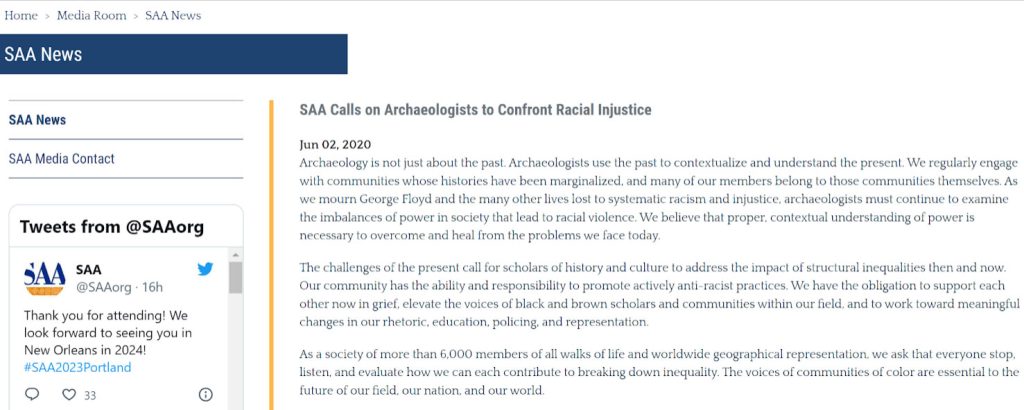
A statement of solidarity with the Black Lives Matter movement by the SAA Board of Directors.53
Pseudoarchaeology at the SAA 86th Annual Meeting
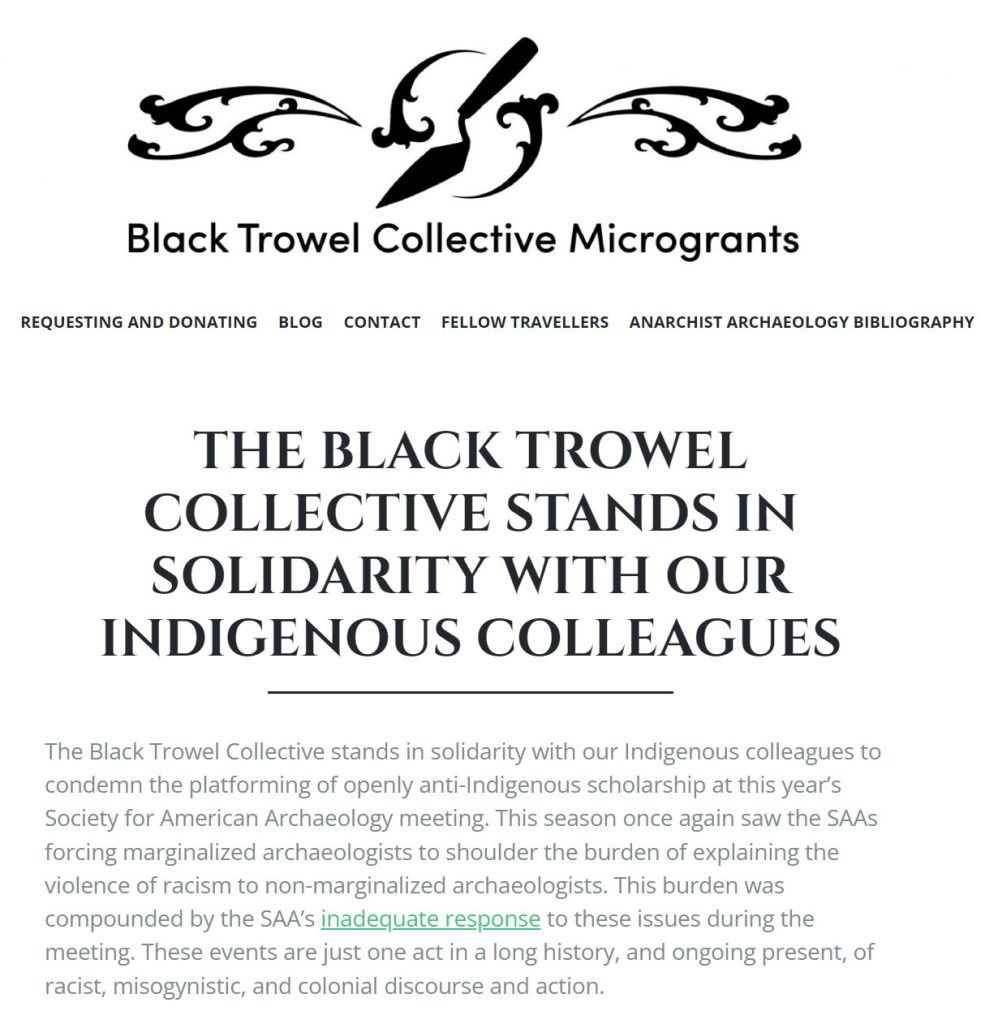
The first paragraph of a statement issued by nonprofit antiracist organisation of activist archaeologists, Black Trowel Collective, published on April 19th 2021.54
At 16:45 on Thursday 15 April 2021, White Archaeology advocates Professor Elizabeth Weiss of San Jose State University and her co-author James Springer delivered a presentation as part of the SAA’s 86th Annual Meeting entitled, ‘Has Creationism Crept Back Into Archaeology?’.55 The abstract for their presentation is as follows:

White Archaeology advocates, aka pseudoarchaeologists, consign Indigenous epistemology to the realm of ‘creationism’ and ‘religion’, citing a debunked and unscientific supposed earliest date – circa 12,000 years ago – for the peopling of the Americas; aligning themselves with an exclusive ‘scientific process’ and so-called ‘objective’ scientific knowledge; calling on their constitutional rights as citizens established in the eighteenth century, under institutional, systematic, state-led genocide and slavery.
Immediately, a flurry of tweets ensued, initiated by Indigenous archaeologist Emily Van Alst, whose original Tweet is unfortunately unavailable:
That evening, around four hours after the presentation had been given, the SAA tweeted, referring to the “general session”:56
Their statement (cited by the Black Trowel Collective above) is as follows:57
To this, the archaeological community on Twitter immediately responded:
And from there, those on the antiracist side of archaeology went on to tweet #IAmNotTheSAA:
Four days later, Professor of Anthropology at the University of Alberta, Kisha Supernant, spoke with journalist Lizzie Wade for Science magazine:
“There are Indigenous members of the SAA, myself included, and there’s so little care given to how a paper like that might have harmed us,” she says. “It was a very difficult experience to sit through that paper…when your very humanity and human rights are being questioned.” She adds: “People are entitled to hold these views. But whether or not they’re given a platform is up [to SAA].”58
It is indeed considered a privilege – not a right – for members to present at the SAA annual meetings. About this, as part of the same article in Science, SAA President Deborah Nichols is cited as saying:
Members of the program committee, comprised of several dozen volunteers, last year reviewed the title and abstract of Weiss’s and Springer’s talk, as they do for all SAA presentations… “There is a review process, but it is not the equivalent of a peer review for a juried journal,” she says. Few abstracts are rejected. But submissions might be flagged if they analyze looted artifacts, report doing work without the appropriate permits, or promote pseudoarchaeology, such as a belief that aliens built ancient monuments, she says. No one flagged Weiss’s and Springer’s abstract, Nichols says, though she called their argument “dated.”59
Herein lies the problem: neither does the SAA consider racist archaeology to be pseudoarchaeology, nor does it flag submissions for racism. And the SAA president chose to sit on the fence by failing to acknowledge blatant racism, instead preferring to use the term, “dated”. Wade concludes her Science piece with:
For Supernant, it is too little, too late. She’s leaving SAA and hopes to build a new professional organization, tentatively called the Society for Engaged Archaeology. When she tweeted about her idea last week, she received a flood of interest and support. “This was the last straw that galvanized a number of us to seriously start doing that planning,” she says. “I understand that institutions are slow to change. But I don’t feel confident that the SAA actually wants to.”60
In this regard, the Black Trowel Collective offers a stark reminder:
While the SAA has situated itself as a key node within the networks of archaeological power in the Americas, and the US in particular, it’s not too big to fall. Structures that try to preserve the top at the expense of the foundation are not sustainable. All trees need roots, all roots need water. Without water, the roots die. Without roots, the tree falls.61
Expressions of White Archaeology: individual perspectives
To gain insight into how White Archaeology expresses itself, an investigation into the behaviour and opinions of White Settler archaeologists who are also SAA members is fitting. And there’s no better place to gain this insight than from Twitter, where most North American archaeologists are active.
As seen from the abstract of the SAA pseudoarchaeology presentation given by Weiss and Springer, White Archaeology’s main qualm appears to be its loss of superiority – its loss of groups, individuals and belongings as objects of their materialist scientific enquiry – which they see as ‘real’ science in lieu of antiracist science, which prioritises co-authorship and collaboration with, and the epistemological or methodological sovereignty of the cultures, individuals and groups that the archaeological process concerns.
Movement from White Archaeology or pseudoarchaeology to antiracist archaeology or archaeology causes a loss of what Flewellen et al describe as “white innocence”:
As Clarke observed, “The consequences arising from the introduction of new methodologies are of far greater significance than the new introductions themselves”. What wide-ranging consequences for the narratives we tell—and the shape of archaeology itself—might we see in the coming decades if we change our methods of writing, researching, and teaching archaeology, and allow this time for a loss of white innocence?62
A consequence of the “loss of white innocence” among North American archaeologists is, unfortunately, confrontation between BIPOC and White Settler scholars, such as this occurrence between Professor Kisha Supernant of the University of Alberta, and Professor John Hoopes of the University of Kansas. On December 14th 2022, Professor Supernant tweeted:
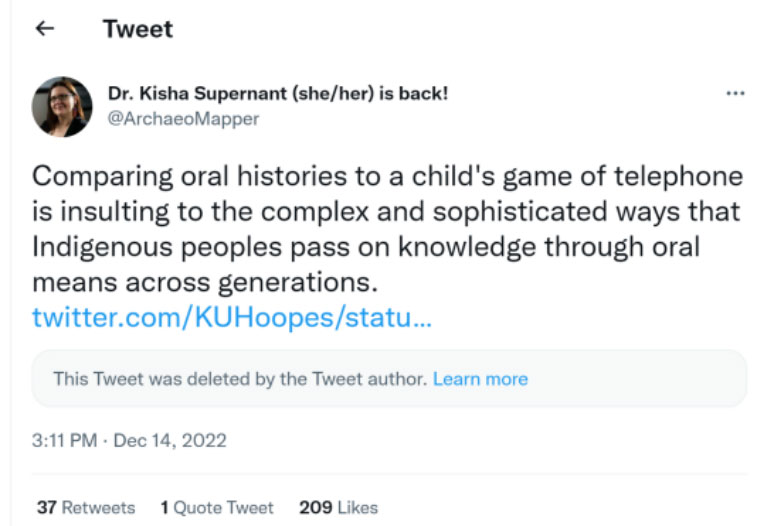
Professor Kisha Supernant responds critically to Professor Hoopes, who has deleted his original Tweet.63
In reply, Hoopes maintained his position and defended his opinion:
To which Supernant reiterated her position, and Hoopes again defended his:
Their confrontation came to an end with Supernant’s respectful attempt to educate Hoopes by taking up empirical sovereignty or ownership over the Indigenous methods that he referenced.
Unfortunately, Hoopes was not prepared to give way to Supernant’s sovereignty:
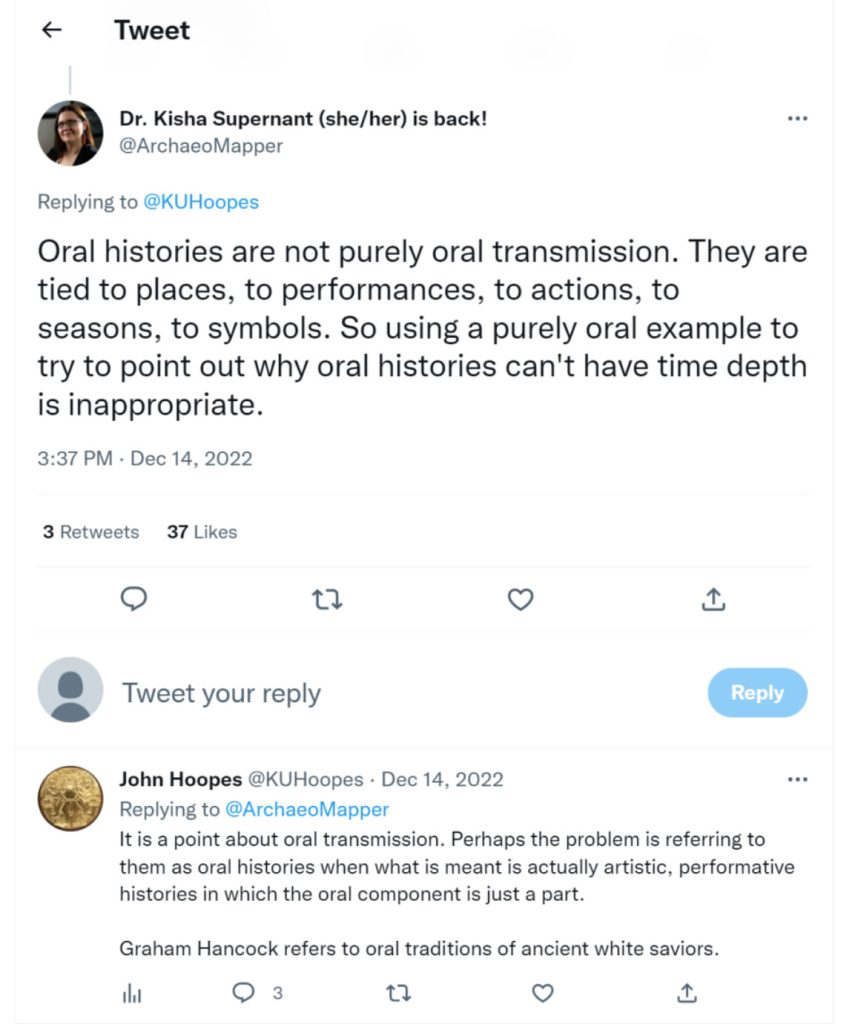
Hoopes attempts to maintain his position as an authority on a subject that is irrefutably not his own by not giving way and instead claiming that the concept, ‘oral histories’ is problematic. He then seeks to disguise his own racism by citing someone – Graham Hancock – who he deems to be a ‘bad’ other.
From an antiracist perspective – rather than accept the education respectfully offered by Supernant, who represents the source of the subject he referenced, Hoopes attempted to position himself as an authority on that subject, which White Archaeology appropriated from Indigenous nations. Hoopes went on to deflect his racism by citing someone that he deems to be a ‘bad’ other, choosing to not acknowledge, apologise for or learn from the racism that he was called out for.
Having caught wind of the confrontation between Supernant and Hoopes, others commented:
Suffice it to say, as users ‘Pattie Garcia’ and ‘Curt’ explain, to surmise that Indigenous people may not be “mature enough” to “develop strategies” for teaching oral histories, and to compare Indigenous history keeping to a children’s game, is an expression of racist White Archaeology or pseudoarchaeology. Bill White articulates this well:
White archaeologists…will expect non-white people to recognize their expertise in something they can never experience themselves and barely even understand. They will expect us to give them our cultural knowledge so they can further their own careers but will tell us it’s to help us save our own heritage. We might have free access to some of their articles and will get to watch them speak for us on TV… White archaeologists will get angry if anyone challenges them on this.64
From an antiracist perspective, Hoopes, who has made it his ”personal and professional mission to ferret out pseudo-science in the field of archaeology;” who defines pseudoarchaeology as “the stuff that you find in the grocery checkout counter or the airport book rack;” who positions himself within White Archaeology as a ‘specialist’ in “Mayan culture spanning the conjunction of North, Central and South America,” acts as a White Archaeology advocate, aka a pseudoarchaeologist.65

Professor John Hoopes is editor of and contributor to a SAA 2019 edition of its membership magazine entitled, ‘Pseudoarchaeology, Scholarship and Popular Interests in the Past and Present’.
In fact, not only does Hoopes insult Indigenous people by assuming sovereignty through his scholarly ‘specialism’ over their knowledge systems (as seen from his confrontation with Professor Supernant on Twitter); but also it is his belief that ‘Afrocentricism’ and its “mainly African American adherents” who “regard themselves and all other Blacks as syncretic Africans and believe that their worldview should positively reflect traditional African values,” do not belong in archaeology, history or science at all:66
While antiracist archaeologists tend to describe pseudoarchaeology as that which excludes, side-lines or objectifies the perspectives of BIPOC authors and knowledge systems in the archaeological process, self-proclaimed ‘pseudoarchaeology expert’, Professor John Hoopes (left), describes Afrocentrism as “a pseudohistory, a pseudoscience, or a pseudoarchaeology;” in other words, a fake history, a fake science, or a fake archaeology.67 [source]
‘Good’ us v ‘bad’ others: White Archaeology’s expression of superiority
Where White Archaeology reigns, claims of scientific hierarchy or ‘good’ versus ‘bad’ archaeologies, histories and science pervade, thus maintaining toxic environments where harassment can thrive. Heath-Stout found this when conducting interviews for her PhD dissertation, in which she recalls an interview with an archaeologist about racism where:
…By attempting to teach me what language I should use, she positioned herself as the expert, and therefore non-racist, and placed me on the other side of the good/bad binary. She used that energy to teach me rather than to reflect on how her whiteness may have affected her career, deflecting discomfort rather than sitting with it.68
White Archaeology advocates who lack self awareness indeed attempt to position themselves as non-racist teachers or specialists on topics that they have appropriated, against allegedly ‘bad’ others, to deflect their racism – as shown by the confrontation between Supernant and Hoopes.
What comes to mind here is Flewellen et al’s recognition that “white saviors” frequently function as “undercover agents of the system from which their power flows”.69 A poignant example of this is a Twitter thread posted by SAA member and American archaeologist Flint Dibble from the University of Cardiff:

Dibble responds to ‘Black Lives Matter’ solidarity statements in 2020, quickly positioning himself on the ‘good’ side of the debate against hypothetical ‘bad’ others. Note that 7,349 others ‘liked’ his post and 4,436 shared it.
Unfortunately for Dibble, he was called out not only for his hypothetical and imaginary ‘bad’ others but also for his unscientific and unrigorous lack of citations:
To this, Dibble responded by explaining that he did not mean to criticise White Settler archaeologists apart from the explicitly racist ones of the nineteenth century:

Note how 83 other Twitter users ‘liked’ Dibble’s surmising of hypothetical racist ‘others’ who do not value African history. Dibble is seemingly unaware of the racist systems of archaeology that he contributes to daily.
Though a rather large number of people – 83 at the time of writing – agree with Dibble’s surmising of the racist ‘others’ who do not value African history, user ‘Arlome’ was not the only one with questions:
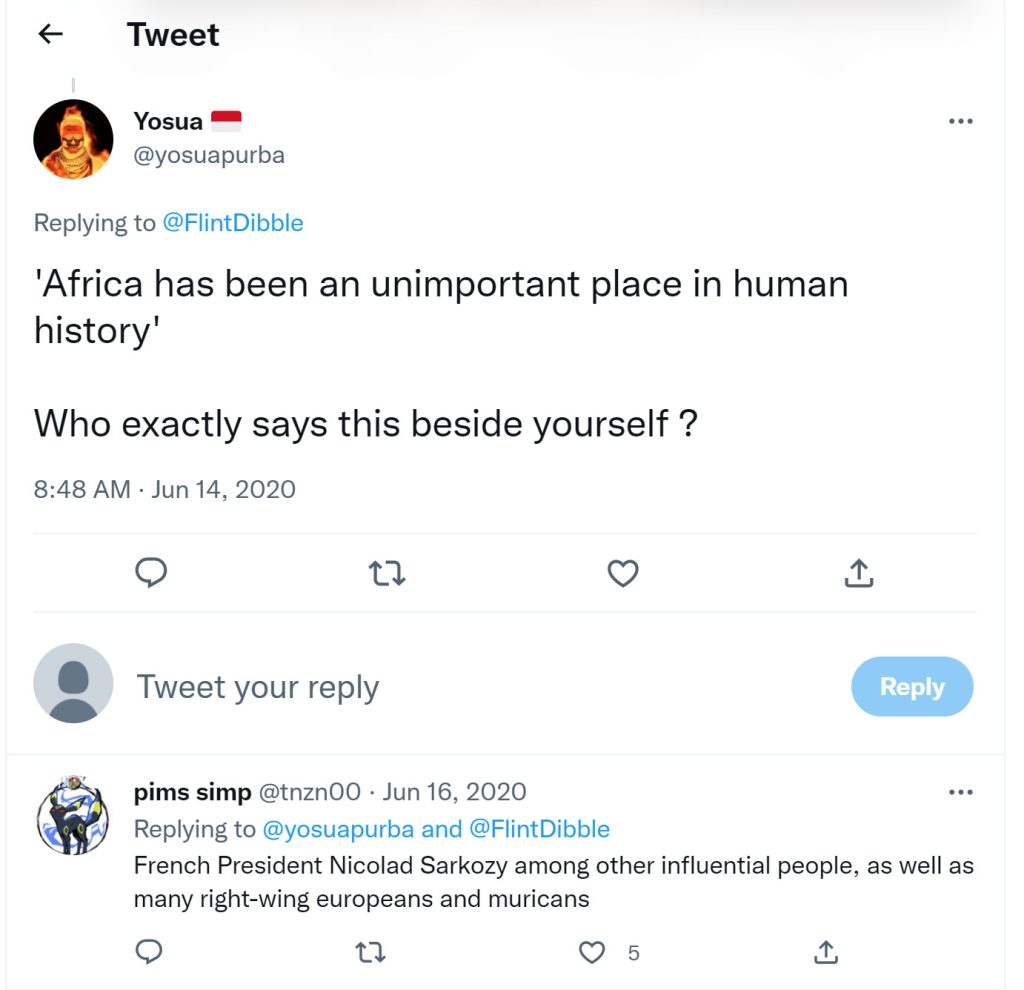
Dibble is called out for critiquing hypothetical ‘others’ for racism, whom he explicitly stated are not currently practising White Settler archaeologists, and ‘maybe some’ in the nineteenth century.
According to Dibble’s reasoning, his hypothetical ‘bad’ others existed in the nineteenth century and seemingly did not exist among White Archaeology in June 2020, at his time of writing. Given that the existence of ‘bad’ racist others is, however, necessary to secure his default position on the ‘good’ non-racist side of the debate, it is regrettable yet unsurprising to see him depart on a crusade against whom he and White Archaeology conveniently consider to be ‘bad’ — their critics:
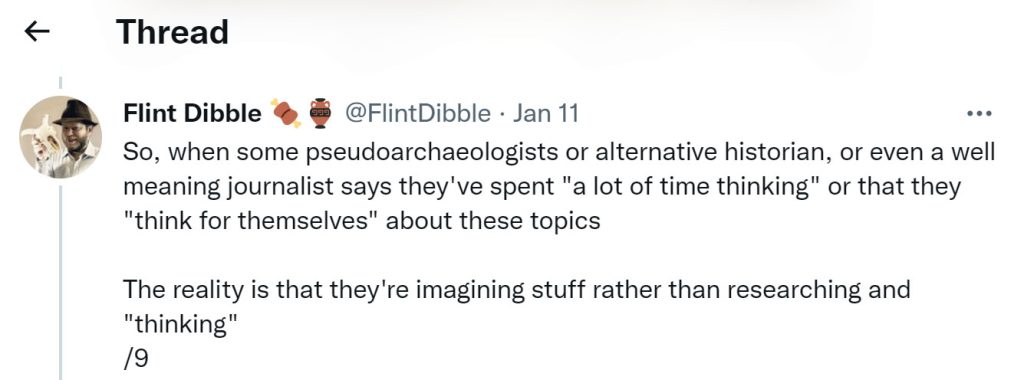
White Archaeology, with its monopoly of the archaeological record, encourages harassment and intimidation of its critics, in attempt to maintain epistemological sovereignty.
The problem here is not only the maintenance of what anthropologist Barbara Voss describes as the “epidemic” culture of harassment, bullying and intimidation of White Archaeology, but also what this student of archaeology articulates succinctly here:70
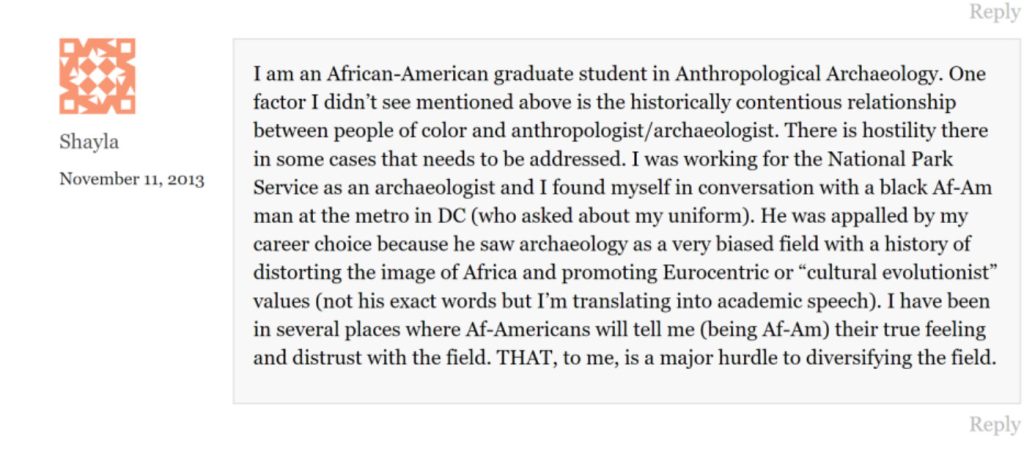
A comment left by a grad student, ‘Shayla’, on a piece written by Doug Rocks-Maqueen in 2013 titled, ‘Archaeologists, The Whitest People I Know’.71
As Shayla explains, White Archaeology’s determination to castigate and shame those who put forward different or multiple perspectives on the past maintains its reputation as a “Eurocentric”, “biased” field “with a history of distorting the image of Africa” and “promoting…cultural evolutionist values”.
A stark expression of the distortion and ownership of African history by White Archaeology are these examples from another Flint Dibble Twitter thread:
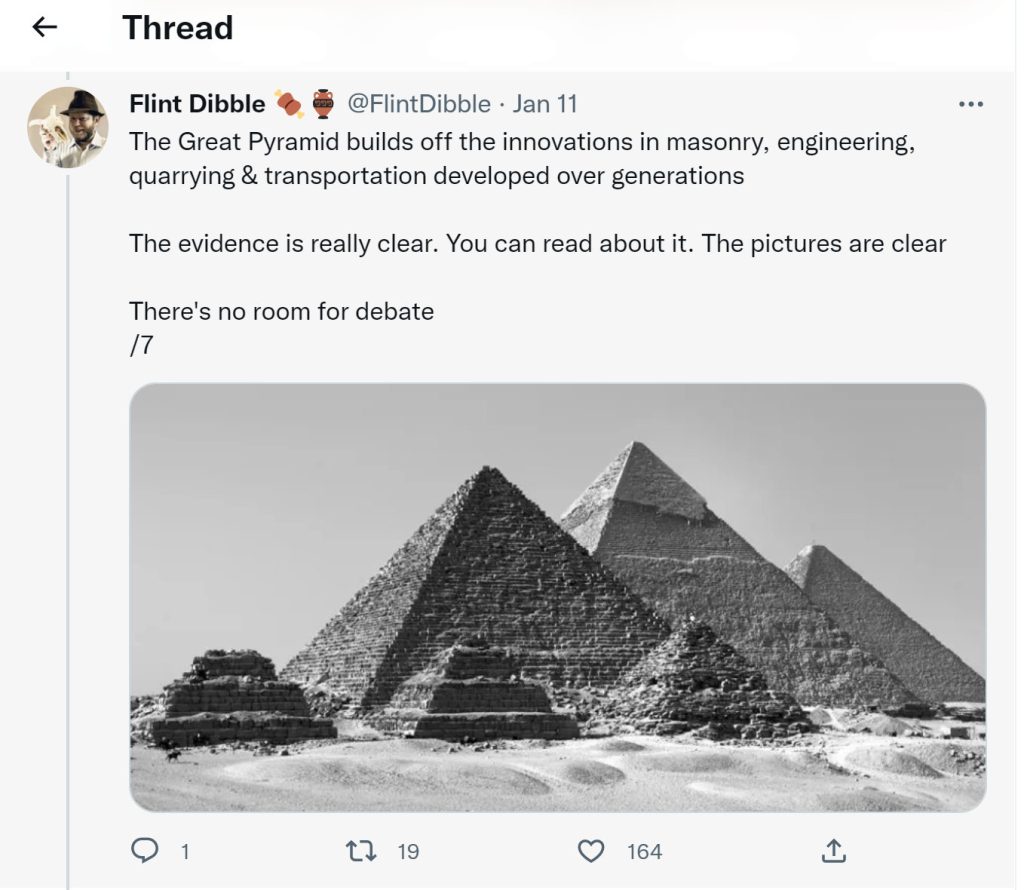
Dibble claims that White Archaeology has already written ancient Egyptian history, so there is “no room for debate” or alternative perspectives.
As Maria Franklin wrote as part of the introduction to her seminal 1997 article on the historiography of antiracist archaeology:
‘Why are there few black American archaeologists?’ is a question only now being raised as it relates to the appropriation and social construction of the past by archaeologists. These issues are significant if one believes that archaeological interpretations are often uncritical histories created by state-supported specialists whose work is widely used to justify, not challenge, ‘existing power relations’.72
Flint Dibble, son of the renowned and widely respected American archaeologist, the late Professor Harold Dibble, seems to be unaware of the implications of his belonging to the ‘privileged few’ White Settler men who have dominated archaeology. As Bill White reminds us:
[White people] are rightfully ashamed of the actions of preceding generations of whites and do not want to be associated with these activities, which is why they quickly disassociate themselves from racism by turning discussion towards overtly racist individuals they have heard of or know. Also, they do not want to believe that their hard-earned lifestyle was the result of anything other than hard work. Nobody wants to acknowledge the head start they’ve gotten simply by being born in the United States, growing up with a middle class background, or being born white.73
Given that Dibble considers himself to be on the ‘good’ non-racist side of archaeology and perhaps does not intend to propagate White Archaeology, aka racist archaeology, aka pseudoarchaeology, a journey into awareness of himself and his position, his responsibility as a White male archaeologist, and what it means to be an antiracist accomplice could work to his advantage here:
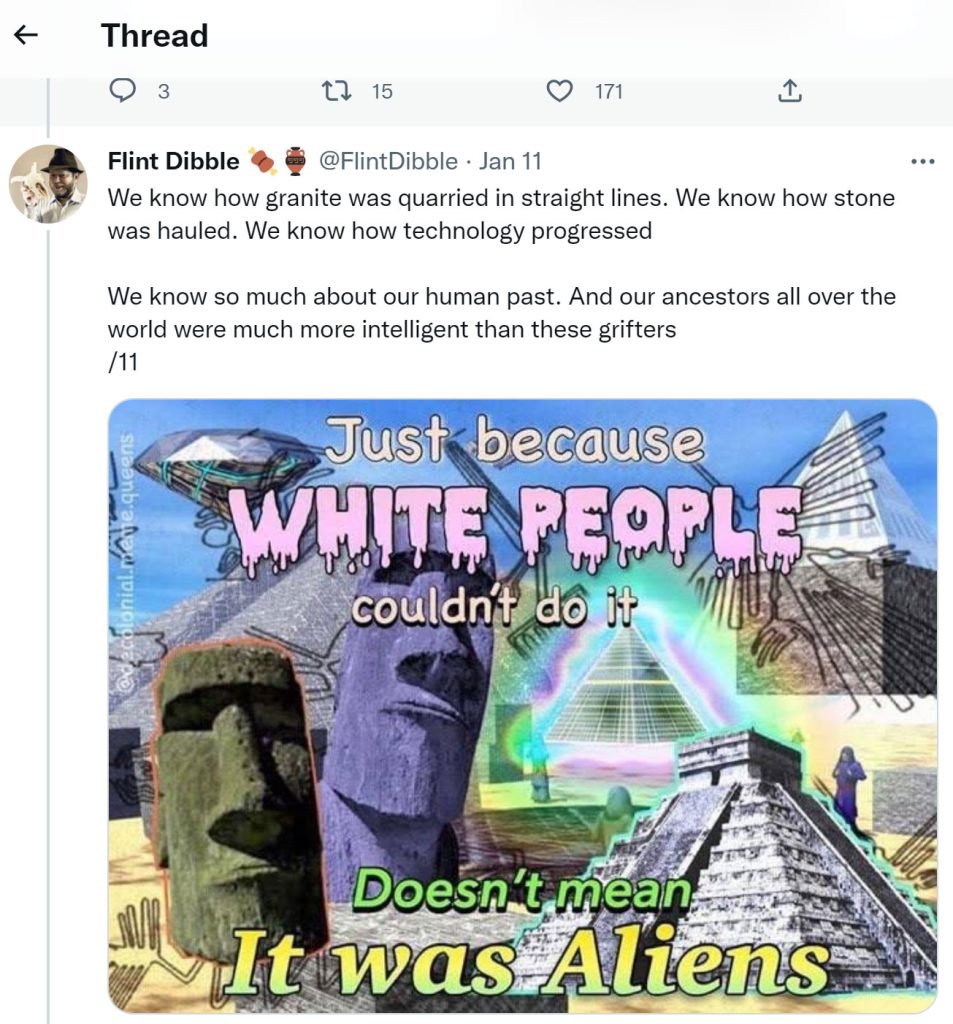
Dibble is an expression White Archaeology’s ownership of world history and its assumption of epistemological superiority by claiming that the past has already been written. Meanwhile, Dibble attempts to position himself on the ‘good’ antiracist side of archaeology, against ‘bad’ racist others, without acknowledging or citing either antiracist perspectives or the racism of the accused ‘bad’ others.
Suffice it to say, there is much about ancient Egyptian history that is not understood, and to claim that this history has already been written by White Archaeology is to propagate a racist, unrepresentative, and frankly ‘fake’ or ‘pseudoarchaeological’ view of the past.
Antiracism begins with self-awareness and the deflection of racism by archaeologists onto others only perpetuates the persistence of White Archaeology or pseudoarchaeology and the institutional racism, harassment and bullying it encourages. In the words of Bill White:
…Whites tend to focus on the actions of individuals without acknowledging the fact that structural racism exists in the United States. They try to distance themselves from racism by highlighting the fact that other people discriminate; it’s a problem but they aren’t the cause.74
Until White Archaeology and its archaeologists shift perspective from allegedly racist ‘others’ onto themselves and employ the self-awareness necessary to become antiracist accomplices, racism in archaeology or pseudoarchaeology will continue to thrive.
(Re)defining science, archaeology and pseudoarchaeology
Touching back upon the Science article that cites SAA president at the time, Debora Nichols, outlining the membership organisation’s platforming review procedure for their annual meetings:
…Submissions might be flagged if they analyze looted artifacts, report doing work without the appropriate permits, or promote pseudoarchaeology, such as a belief that aliens built ancient monuments, she says. No one flagged Weiss’s and Springer’s abstract, Nichols says, though she called their argument “dated.”75
Clearly, the SAA and the institution of White Archaeology that it serves, must prioritise archaeologies that define what it means to write, propagate and support archaeology in accordance with antiracist perspectives that intersect with other topics relevant to BIPOC communities, like feminist and LGBT+ issues. A wise move would be to publish a ‘pseudoarchaeology’ issue of their quarterly membership magazine specifically advocating antiracist archaeologies.
After all, what constitutes ‘pseudoarchaeology’ depends on how science is defined. A step in the right direction could be to redefine ‘science’ in the context of archaeology, from its appeal to the exclusive, so called ‘objective’ and materialist view, to a pluralist definition that includes the knowledge systems held by the communities that the archaeological process concerns.
Indigenous archaeology, for example, “does not necessarily reject the tenets of scientific inquiry, but does challenge the legacy of scientific colonialism and the hegemony of western knowledge,” state Director of Native American Studies at the University of Oaklahoma, Joe Watkins, and his co-author, Professor George Nicholas:
Indigenous archaeologists seek to mobilize knowledge about the past by ensuring that (a) archaeological practices are respectful of local values, including treatment of ancestral remains; (b) local definitions of “significance” are employed in the identification and protection of heritage sites; and (c) the results of archaeological investigations are relevant to the living community.76
Flewellen et al. describe Black archaeology similarly, as being “ever-changing in light of the shifting experiences and needs of the descendants with which [they] seek to work”, as well as
…Explicitly political and grounded in intersectional analyses. It entails collaboration with descendant communities and seeks redress, through dialogue with them, of the harms that archaeology and heritage practices have perpetrated against communities of color.77
Antiracist Chinese diaspora archaeologies are similarly described by Fong et al. through four themes: “fostering community collaboration, understanding multiethnic communities, examining gender and sexuality, and exploring transpacific connections.”78
An antiracist revolution does not seek to expel the perspectives advanced by White Archaeology, but rather to expand the archaeological process to include and welcome multiple methods, perspectives and stories about our past, as outlined by Flewellen et al. in ‘The Future of Archaeology is Antiracist’:
Phase 1 involves knocking down the walls of dominant practices within archaeology that perpetuate systems of oppression. Phase 2 invites us to take an active role in building an antiracist foundation to support a new house. Taking lessons learned from Black feminist theorists, critical race scholars, antiracist advocates, and champions of social justice, Phase 3 establishes the framework of this new house by expanding the epistemological legacies on which we draw. Phase 4 centers on mentorship as the key to ensuring the sustainability of an antiracist archaeology.79
In other words, in becoming a community-centred service that acts in the interest of BIPOC people, cultures, history and knowledge systems, North American archaeology will become itself. Until then, North American archaeology is White Archaeology, which provides a view of the past that is severely limited by its bias, and frankly ‘fake’ in its failure to represent the peoples and cultures concerned by its institutions, processes and narratives.
Suggested reading
‘Archaeology in the Time of Black Lives Matter’ Resources List, by the Society of Black Archaeologists (2020)
‘Chinese Diaspora Archaeology in North America’, by Chelsea Rose [eds.](2020)
‘The Indigenous Paleolithic of the Western Hemisphere’, by Paulette Steves (2021)
‘Why Antiracism Training is Necessary for Archaeology’, by Bill White (2022)
‘Why the Whiteness of Archaeology is a Problem,’ by William White and Catherine Draycott (2020)
References
1 Kelly Fong et al., ‘Race and Racism in Archaeologies of Chinese American Communities’ on Annual Review of Anthropology (2022), p. 236.
2 Audrey Smedley, ‘The History of the Idea of Race’ on Britannica: https://www.britannica.com/topic/race-human/The-history-of-the-idea-of-race.
3 Paulette Steves, The Indigenous Paleolithic of the Western Hemisphere (University of Nebraska Press, 2021), pp. 27-30. See also David Klinghoffer, ‘Meet Aleš Hrdlicka, FDR’s Favorite Eugenicist’ on Evolution News (May 2018): https://evolutionnews.org/2018/05/meet-ales-hrdlicka-fdrs-favorite-eugenicist/.
4 See for example Paulette Steves, The Indigenous Paleolithic of the Western Hemisphere, pp. 36-54, about the controversy concerning the cultural affiliation, racial classification, facial reconstruction and repatriation of the individual excavated in 1996 who is known to Indigenous nations as ‘The Ancient One’ and to archaeologists as ‘Kennewick Man’. “In his silence”, writes Steves on page 39, “Kennewick Man speaks volumes about ongoing racism in American anthropology. The Ancient One carries a strong message that racism is active in academic circles, is still being taught and passed on, and is still negatively impacting Indigenous peoples.”
5 Dianne Gifford-Gonzalez & Anna S. Agbe-Davies, ‘THE SAA’S HISTORICALLY UNDERREPRESENTED GROUPS SCHOLARSHIPS FUND: A NEW OPPORTUNITY AND CHALLENGE’, on The SAA Archaeological Record (November 2012), p. 12.
6 Laura Heath-Stout, ‘Who Writes About Archaeology? An Intersectional Study of Authorship in Academic Journals’, on American Antiquity 85(3), (2020), p. 421.
7 Jess Beck et al., ‘Prestige or Perish: Publishing Decisions in Academic Archaeology’, on American Antiquity 86(4), (2021), p. 673.
8 Laura Heath Stout & Elizabeth Hannigan, ‘Affording Archaeology: How Field School Costs Promote Exclusivity’, on Advances in Archaeological Practices 8 (2), 2020, p. 128.
9 Laura Heath-Stout describes herself as ‘White Settler’, presumably to acknowledge her position as a descendant of colonial White Settler Americans in relation to Indigenous Americans. She has focused her career on bringing awareness and finding solutions to racism and other forms of discrimination in archaeology (much of her research is included in this report.) Her belonging to the minority group of White Settler archaeologists in North America that are in the words of Black archaeologists Flewellen et al, ‘antiracist accomplices’ is indicated here, in the introduction to her PhD dissertation, where she recounts her pursuit of a career in archaeology:
“How can you be an archaeologist when the Smithsonian paid people to cut off Native heads on the battlefield and send them back to Washington to prove white people are smarter? How can you be part of that?”
I was a sophomore in a Native American Studies class, where I was the only archaeologist. It was my favorite class, a small seminar, all women, where we sat around a big table drinking tea and talking about fascinating topics. That day, when we read our professor’s research on the history of the Smithsonian and its skull collections (Clouse 2009), the conversation got heated. One of the Black women in my class confronted me with the racism in which my discipline was rooted, and I did not have a good answer for her.
After class, I called my mother in tears, and said I had to quit archaeology. I had to do something good for the world, maybe be a public school teacher. My mom pointed out that if I thought public schools were free of racism, I had not been paying attention to her work stories for all these years. She said that what the world needs is people who love what they do and try to do it ways that make the world better, and reminded me that I had loved archaeology for years. She told me that if all of the archaeologists who are appalled by racism quit, archaeology would continue to be used to support white supremacy, colonialism, and genocide. I went to my professor’s office hours, and she told me about her work in the Smithsonian’s repatriation office, returning those human remains to their descendants. I wrote a term paper about indigenous and collaborative archaeologies. I took a class in feminist archaeology. I learned that I was not alone in struggling with the racist, colonialist, sexist, and otherwise oppressive history of my field, and there were many archaeologists working for justice. I continued to pursue a career in archaeology, helped along by my race and class privilege. Ten years later, I am still wrestling with my classmate’s question, and I am sure that I will be for as long as I work in archaeology. I am grateful to her for asking it. This dissertation is part of my answer.
10 Laura Heath-Stout, ‘Who Writes About Archaeology? An Intersectional Study of Authorship in Academic Journals’, p. 408.
11 Laura Heath-Stout, ‘Diversity, Identity and Oppression in the Production of Archaeological Knowledge’, PhD dissertation, Boston University, (2019), p. 6.
12 Ayana Omilade Flewellen et al., ‘The Future of Archaeology is Antiracist: Archaeology in the Time of Black Lives Matter’, on American Antiquity 86(2), 224-243, (2021), p. 232.
13 See for example, the book controversially published by University Press of Florida in 2020 by anthropologist Professor Elizabeth Weiss and retired attorney James Springer: Repatriation and Erasing the Past, the synopsis for which reads:
“Engaging a longstanding controversy important to archaeologists and indigenous communities, Repatriation and Erasing the Past takes a critical look at laws that mandate the return of human remains from museums and laboratories to ancestral burial grounds. Anthropologist Elizabeth Weiss and attorney James Springer offer scientific and legal perspectives on the way repatriation laws impact research.
Weiss discusses how anthropologists draw conclusions about past peoples through their study of skeletons and mummies and argues that continued curation of human remains is important. Springer reviews American Indian law and how it helped to shape laws such as NAGPRA (the Native American Graves Protection and Repatriation Act). He provides detailed analyses of cases including the Kennewick Man and the Havasupai genetics lawsuits. Together, Weiss and Springer critique repatriation laws and support the view that anthropologists should prioritize scientific research over other perspectives.”
In response to outcry among the archaeological community, particularly on Twitter, University of Florida Press issued a statement apologising for the ‘pain caused’ by their publication of the book: UF-Press-memo. Also see Weiss’ series of articles published by White Archaeology organisations National Association of Scholars and Minding The Campus.
14 For example, see the opinions of White Archaeology proponents in the comments on the recording of Professor Weiss’ presentation platformed by the SAA at their Annual Meeting in 2021, here: https://www.youtube.com/watch?v=bZ5HNimJU08&ab_channel=ElizabethWeiss.
15 See here a few examples of many: David Ludwig & Stéphanie Ruphy, ‘Scientific Pluralism’ on The Stanford Encyclopedia of Philosophy (Winter 2021 Edition), Edward N. Zalta (ed.), https://plato.stanford.edu/archives/win2021/entries/scientific-pluralism/; The Indigenous Science Network, https://wisn.org/; and Professor of Integral and Transpersonal Psychology at the California Institute of Integral Studies, Dean Radin talking about the ‘pan-psychic’ view of science that suggests a non-dualistic approach to consciousness and matter: https://closertotruth.com/video/radde-005/.
16 Dr. Sara L. Gonzalez on Twitter, December 14 2022. See the full thread including comments by Dr. Paulette Steves here: https://twitter.com/potatokitty/status/1603085294349475840.
17 Ayana Omilade Flewellen et al., ‘The Future of Archaeology is Antiracist: Archaeology in the Time of Black Lives Matter’, p. 238.
18 ibid.
19 ibid., p. 234.
20 ibid.
21 Kelly Fong et al., ‘Race and Racism in Archaeologies of Chinese American Communities’, p. 244.
22 ibid, p. 239.
23 ibid, p. 235.
24 Kaylee Prewski et al., ‘VIEWS ON THE NINE PRINCIPLES OF ARCHAEOLOGICAL ETHICS FROM THE 2020 SAA ETHICS SURVEY’ on The SAA Archaeological Record, March 2021’, p. 38.
25 See Ayana Omilade Flewellen et al., ‘The Future of Archaeology Is Antiracist: Archaeology in the Times of Black Lives Matter”, p. 233: ‘Four Phases of Building an Antiracist Archaeology’, ‘Phase III: Rebuilding and Planning Phase: To revisit the current therorizations of race’ and ‘problematize the social construction of race as a basis for the denial of racism’.
26 Maria Franklin, ‘Why Are There So Few Black Archaeologists?’ on Antiquity 71(274): 799-801,
p. 799.
27 ibid.
28 Dianne Gifford-Gonzalez & Anna S. Agbe-Davies, ‘THE SAA’S HISTORICALLY UNDERREPRESENTED GROUPS SCHOLARSHIPS FUND: A NEW OPPORTUNITY AND CHALLENGE’, p. 12.
29 Zippia, ‘Archaeology Demographics and Statistics in the US’. Accessed in December 2022: https://www.zippia.com/archaeologist-jobs/demographics/.
30 Figure corroborated by 2015 data: Laura Heath Stout & Elizabeth Hannigan, ‘Affording Archaeology: How Field School Costs Promote Exclusivity’, p. 124. re 2015 needs assessment survey where just 0.8% identified as Native American or Alaska Native.
31 Doug Rocks-Macqueen, ‘Archaeologists, The Whitest People I Know’ on Doug’s Archaeology (October 15 2013): https://dougsarchaeology.wordpress.com/2013/10/15/archaeologists-the-whitest-people-i-know/.
32 Bill White, ‘Are Archaeologists Racist? (Part 1)’ on Succinct Research (2015): https://www.succinctresearch.com/are-archaeologists-racist-part-i/.
33 Laura Heath-Stout, ‘Diversity, Identity and Oppression in the Production of Archaeological Knowledge’, p. 3: ‘there is limited quantitative literature on the racial and sexual orientation demographics of archaeology’.
34 Dianne Gifford-Gonzalez & Anna S. Agbe-Davies, ‘THE SAA’S HISTORICALLY UNDERREPRESENTED GROUPS SCHOLARSHIPS FUND: A NEW OPPORTUNITY AND CHALLENGE’, p. 12.
35 ibid., p. 15.
36 Laura Heath Stout & Elizabeth Hannigan, ‘Affording Archaeology: How Field School Costs Promote Exclusivity’, p. 128.
37 ibid., p. 127.
38 ibid., p. 128.
39 ibid.
40 Bill White, ‘Are Archaeologists Racist? (Part 1)’.
41 Barbara Voss, ‘Documenting Cultures of Harassment in Archaeology: A Review and Analysis of Quantitative and Qualitative Research Studies’ on American Antiquity 86(2) 1-17, (2021), p. 244.
42 ibid., p. 252.
43 Kaylee Prewski et al., ‘VIEWS ON THE NINE PRINCIPLES OF ARCHAEOLOGICAL ETHICS FROM THE 2020 SAA ETHICS SURVEY’, p. 38.
44 Maria Franklin et al., ‘The Future is Now: Archaeology and the Eradication of Anti-Blackness’ on International Journal of Historical Archaeology 24, 753–766 (2020), p. 762.
45 Kaylee Prewski et al., ‘VIEWS ON THE NINE PRINCIPLES OF ARCHAEOLOGICAL ETHICS FROM THE 2020 SAA ETHICS SURVEY’, p. 38.
46 ibid., pp. 33, 35.
47 ibid., p. 37.
48 ibid., p. 38.
49 Taken from Alison Wylie’s biography available on her website, here: https://alisonwylie.net/.
50 ibid., p. 37.
51 ibid., p. 38.
52 Bill White, ‘The 2020 Uprisings and Archaeology’s Response’ on Succinct Research (June 27 2020): https://www.succinctresearch.com/the-2020-race-uprisings-and-archaeologys-response/.
53 The SAA, ‘SAA Calls on Archaeologists to Confront Racial Injustice’ on SAA News (June 02 2020): https://www.saa.org/quick-nav/saa-media-room/saa-news/2020/06/02/saa-joins-the-national-call-for-comprehensive-justice.
54 Black Trowel Collective, ‘The Black Trowel Collective Stands in Solidarity With Our Indigenous Colleagues’, on Black Trowel Collective (April 19 2021): https://blacktrowelcollective.wordpress.com/2021/04/19/the-black-trowel-collective-stands-in-solidarity-with-our-indigenous-colleagues/.
55 ‘SAA Annual Meeting Abstracts’, p. 345: https://documents.saa.org/container/docs/default-source/doc-annualmeeting/abstract/2021-saa-annual-meeting-abtracts.pdf?sfvrsn=6d753c93_4.
56 SAA Twitter status: https://twitter.com/SAAorg/status/1382790562638598153.
57 Statement is available here: https://docs.google.com/document/d/176dOOtRsCOe4ur4z0THCf5ZGhuSjt_aLZ3k_QZe1zSU/edit.
58 Lizzie Wade, ‘An Archaeology Society Hosted a Talk Against Returning Indigenous Remains. Some Want a New Society’ on Science (April 19 2021): https://www.science.org/content/article/archaeology-society-hosted-talk-against-returning-indigenous-remains-some-want-new.
59 ibid.
60 ibid.
61 Black Trowel Collective, ‘The Black Trowel Collective Stands in Solidarity With Our Indigenous Colleagues’.
62 Ayana Omilade Flewellen et al., ‘The Future of Archaeology Is Antiracist: Archaeology in the Time of Black Lives Matter’, p. 238.
63 See the confrontation on Twitter here: https://twitter.com/ArchaeoMapper/status/1603045047624429570.
64 Bill White, ‘The 2020 Race Uprisings and Archaeology’s Response’.
65 Taken directly from John Hoopes’ bio on an edition of the Kansas Public Radio entitled, ‘When Experts Attack #43 – Archaeology is Science, Pseudoarchaeology is Nonsense’ (December 9th 2022): https://kansaspublicradio.org/show/genres-when-experts-attack/2022-12-09/live-performance-when-experts-attack-43-archaeology-science-pseudo-archaeology-nonsense.
66 Gerald Early, ‘Afrocentrism’ on Encyclopedia Britannica: https://www.britannica.com/event/Afrocentrism.
67 John Hoopes, ‘Netflix, Apocalypses and the Lost Civilisation’ hosted by Bay Area Skeptics (March 10th 2023). The full presentation is available here: https://www.youtube.com/watch?v=S3TyDJ__H-s&ab_channel=BayAreaSkeptics.
68 Laura Heath-Stout, ‘Diversity, Identity and Oppression in the Production of Archaeological Knowledge’, pp. 220-221.
69 Ayana Omilade Flewellen et al., ‘The Future of Archaeology Is Antiracist: Archaeology in the Time of Black Lives Matter’, p. 234.
70 Barbara Voss, ‘Documenting Cultures of Harassment in Archaeology: A Review and Analysis of Quantitative and Qualitative Research Studies’, p. 244.
71 Doug Rocks-Maqueen, ‘Archaeologists, The Whitest People I Know’ on Doug’s Archaeology, October 15 2013: https://dougsarchaeology.wordpress.com/2013/10/15/archaeologists-the-whitest-people-i-know/.
72 Maria Franklin, ‘Why Are There So Few Black Archaeologists?’, p. 799.
73 Bill White, ‘Are Archaeologists Racist? (Part 1)’.
74 ibid.
75 Lizzie Wade, ‘An Archaeology Society Hosted a Talk Against Returning Indigenous Remains. Some Want a New Society’.
76 George Nicholas & Joe Watkins, ‘Indigenous Archaeologies in Archaeological Theory’ in Encyclopedia of Global Archaeology (Springer, 2014), p. 3778.
77 Ayana Omilade Flewellen et al., ‘The Future of Archaeology Is Antiracist: Archaeology in the Time of Black Lives Matter’, p. 228.
78 Kelly Fong et al., ‘Race and Racism in Archaeologies of Chinese American Communities’, p. 239.
79 Ayana Omilade Flewellen et al., ‘The Future of Archaeology Is Antiracist: Archaeology in the Time of Black Lives Matter’, p. 232.






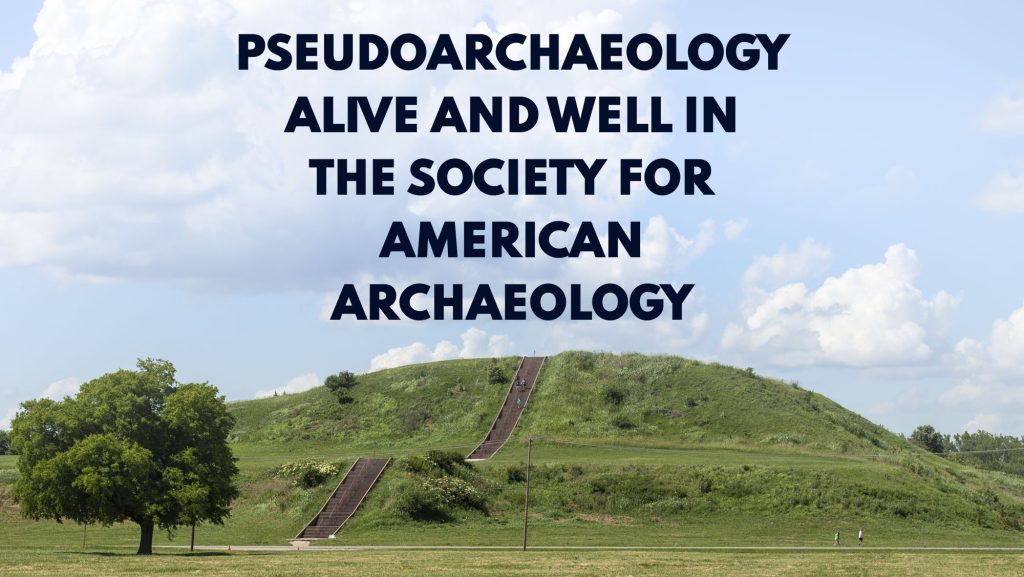

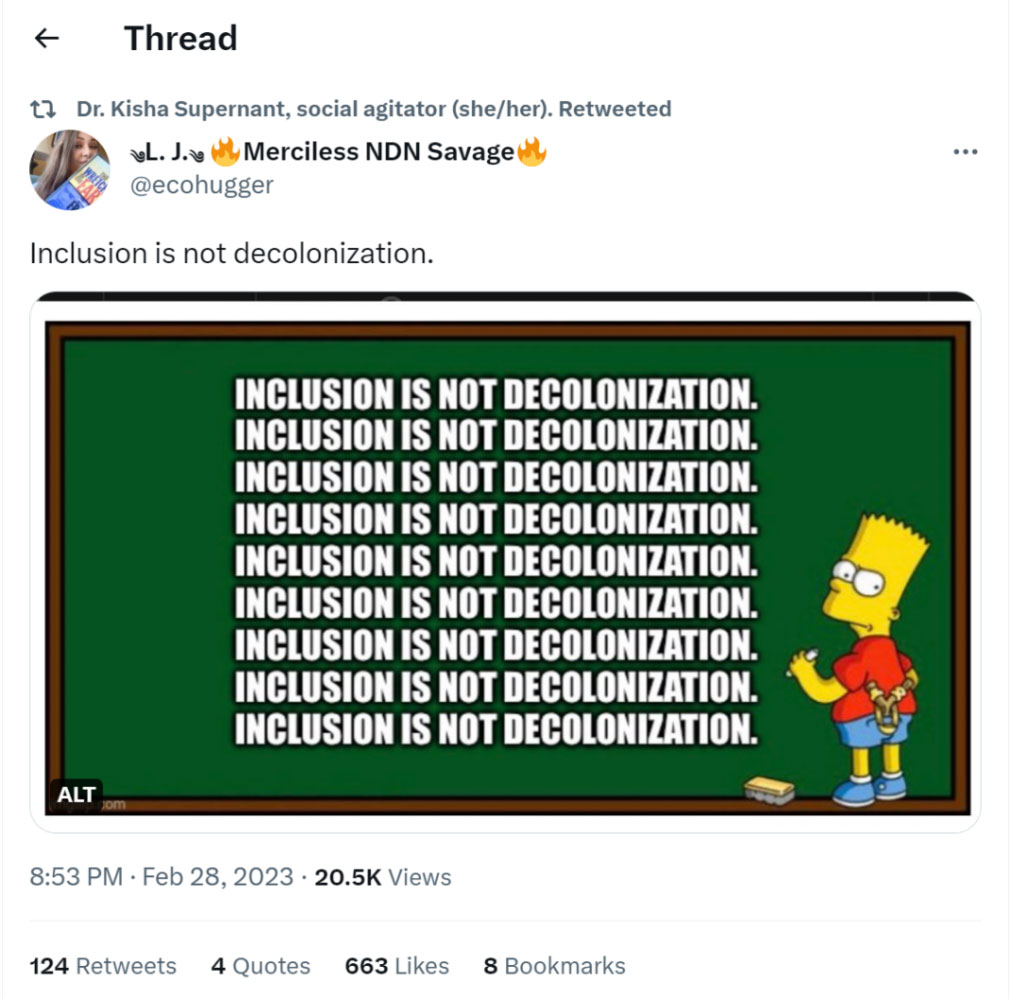


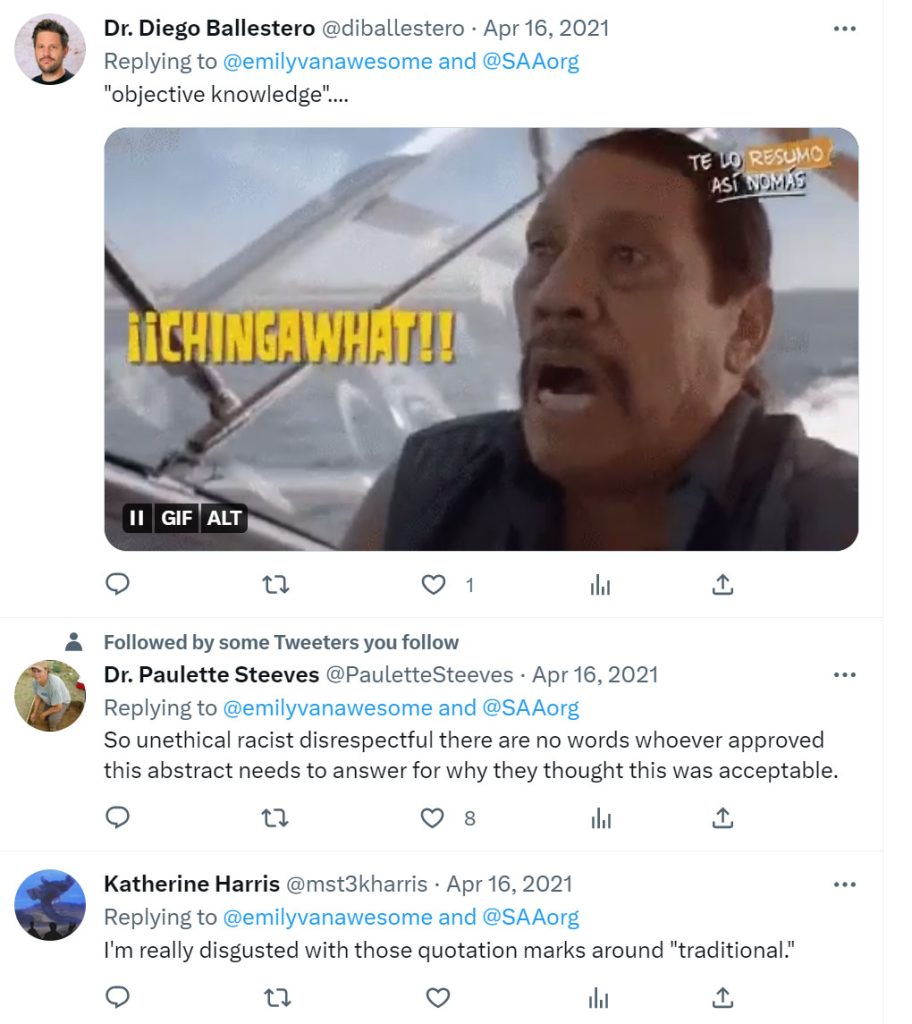

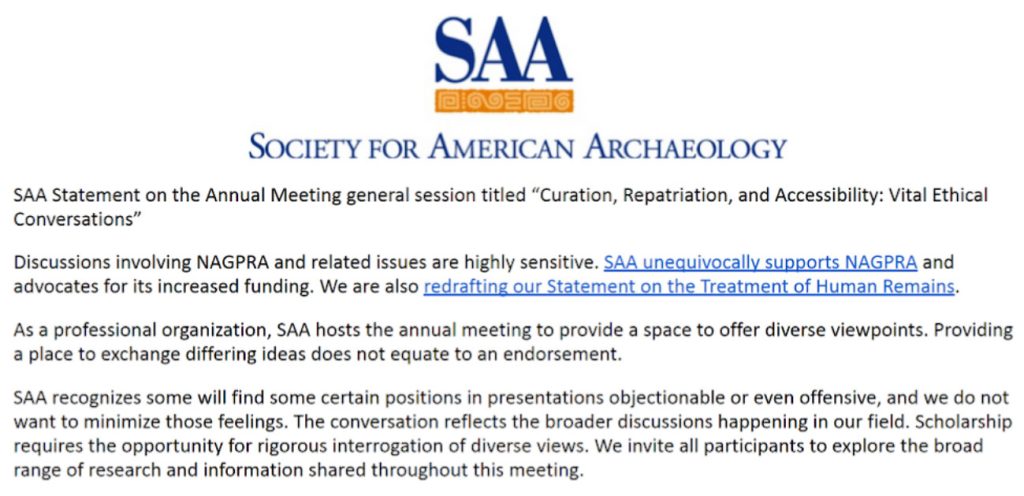
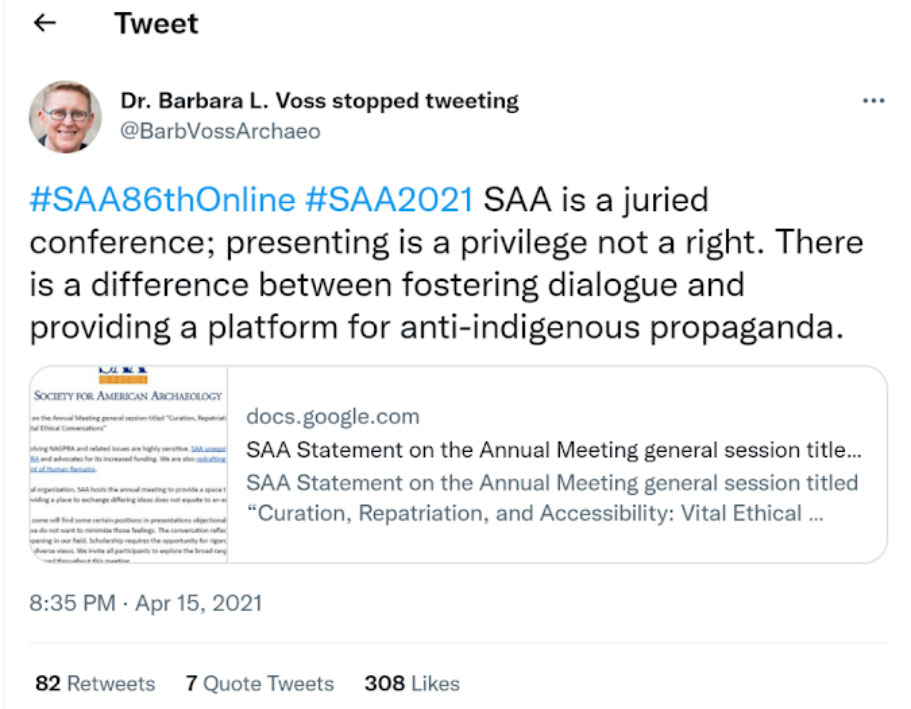


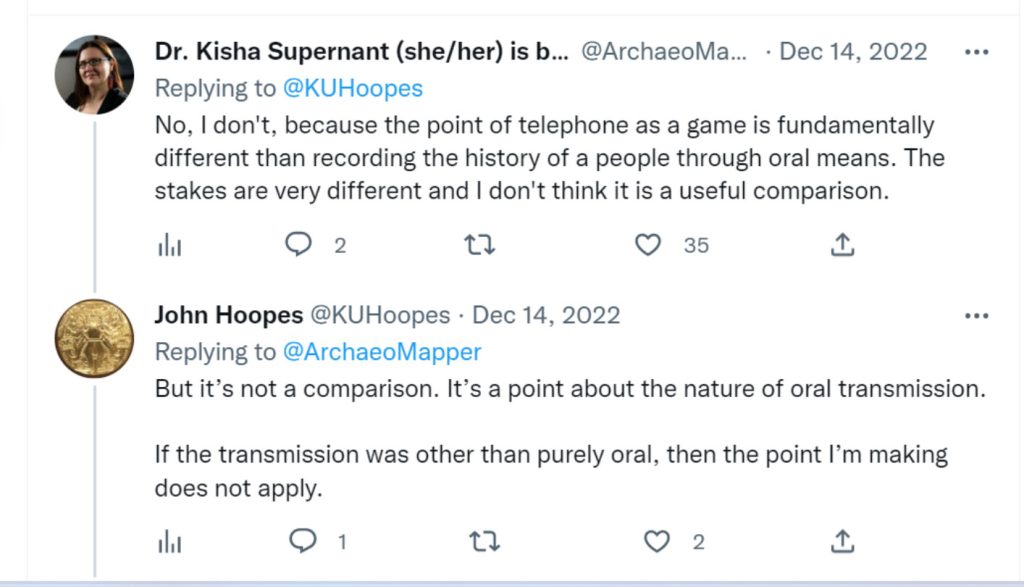



Total flamethrower, great work Holly. All pseudo-skeptics should be forced to read this and attempt to refute it point by point but addiction to being right is a tough drug to kick. So many D bags here, Dawkins, Dibble always have rubbed me the wrong way.
This article is filled with woke propaganda! Graham, I am deeply concerned about where you are being draw by ideas you are not familiar with. Please consider looking into James Lindsey’s work et al on the subject of what is called Critical Social Justice (ask Rogan, he could possibly make an introduction). This ideology is evil and will ultimately destroy humanity if followed to it’s irrational conclusion.
Andrew, I agree with your warning, except that ‘scientific’ ideologies are symptoms, not causes of decline. And only in the human sciences, which are still cultural crafts. I would also like to see ideology stripped out of the human sciences. That would expose their lack of philosophy and theory, and force them back to definitions, hypotheses, theorems, and evidence. We do not evolve, neither does culture, but science is maturing. We could hope to catch up with the brilliant advances in natural sciences and physics. But fix the causes, not the symptoms such as pop anthro errors. They are built on the erros and vacuums in ‘science’.
https://www.youtube.com/watch?v=PBFpGayPATs&t=1s
This documentary ‘New Zealand Skeletons in the Cupboard’ proves that aural stories/tradtions can be passed down over thousands of years & remain 100% completely accurate, proving these racist white Archaeologists 100% wrong with their highly offensive telephone game comparisson.
In the process this doco also proves how racist white Archaeologists in New Zealand are.
And Archaeologists have the nerve to call Graham Hancock racist lol.
What are “cultural evolutionist values? I refer to the grad student Shayla’s comment on Rocks-Maqueen 2013. Does this refer to the general, silent, untheorised assumption that culture ‘evolves’? As in Witzel 2012 /2013? Who is the leading champion of the paradigm of ‘cultural evolution’? I want to comment on a broader issue in anthropology, not the smaller, political issues of racism and contra-racism, born of the larger theoretical and philosophical vacuum in the human sciences.
Regarding the ironies in Hoopes’ view, or the more or less official view of pseudo, I have responded to his journal article in detail among the comments on the SAA letter to Netflix. Perhaps these points are also relevant below this article about the smaller issues, to demonstrate that science, pop science, and culture, all remain cultural crafts, and none rise to the level of science.
The Skinner article above has some rich data for social (contemporary) anthropology, and History of Science, Sociology, and Social psychology.
Here are my responses to Hoopes again:
The archaeology body pretends to recognise its own information bubble in its magazine edition on pop science. But some of the articles raise more ironies, than confidence in their supposed soul-searching.
• Pop science ‘needs ancient aliens’.
But Carl Sagan, Frank Drake, Seth Shostak, and the Search for Extra-Terrestrial Intelligence (SETI), is big science, hugely funded, and more influential in science and culture than the archaeologists acknowledge, even in an edition themed on pop science (SAA Archaeological Record. 2019. Pseudoarchaeology, scholarship, and popular interests in the past and in the present. Nov edition). Hoopes has an apologetic sentence about science using some of the fruits of culture, but does not mention the failures of ‘outreach’. If astronomy were outside the influence of archaeology, then science lacks the integration that pop science seeks.
• Pop science ‘promotes spiritual beliefs in a New Age’.
But human sciences promote siolent assumptions such as ‘cultural evolution’. Hoopes abuses that concept by even applying it to the last century of cult. Supposedly like science also ‘evolves’.
* Pop science seeks ‘hyperdiffusion’ (Whitesides 2019), ‘common source, perennialism.’
But human sciences is built on a paradigm of diffusion (Witzel 2012), inventions, origins, sustained by cultures (plural). Wits University Archaeology department, for example, run their outreach in an ‘Origins Centre’.
* Pop sciences believe in ‘revelatory, metaphysical access to primal, universal truths, not restricted by material methods in time or space.’
But culture is universal (Frazer 1800s etc), primal, metaphysical, across time and space (diachronic). This is no longer contested in anthropology. But no human science has agreed on the causes, not even the effects. The big question for the human sciences, Who and what we are (as Schroedinger posed it), have not been answered. Despite all the self-criticism of Post-Structuralism and Post-Whatever. I discuss this issue in my paper Blueprint, where I demonstrate the role of archetype in cultural media, and thus in perception. Pop science does not currently recognise archetype, because it had ‘evolved’ along with the human sciences, where archtype is ‘stigmatised, forgotten, repressed’. It smacks of cult. Except that Plato in all seriousness (apart from his other jobs as a mythographer and politician), and Heidegger, and Kant, and Jung, worked out part of its philosophy, and Levi-Strauss worked out part of its mechanism. But anthropology had returned to Animism, another ironic fad. Human ‘sciences’ maintain many beliefs (silent assumptions), and are still mainly crafts (which they should study). Despite the advances of cognitive sciences (defence mechanisms known since Freud, and at least eight perceptional Biases known since Wason and others). Psychology had returned to psychiatry (pills), which is better funded, easier, and more popular with patients.
• Western pop sciences follow (Card 2018) ‘the Western esoteric tradition.’
But Renaissance esoterica had some Chinese sources. Victorian esoterica used some Indian sources. Myths in south Pacific cultures follow the same patterns as in civilisations worldwide.
• Esoterica is ‘now in religious studies’ (Goodrick-Clark 2008. Hanegraaff 2005).
But human sciences compartmentalise. Archaeology is mainly ignorant of Divinity. Hoopes (2019) acknowledges that ‘few archaeologists have formal exposure to it.’ Curriculum problem. I wrote three articles on Oracles of the Dead through the ages, as counter-cult to religion (www.stoneprintjournal.wordpress.con)
• Pop sciences have ‘religious implications, not yet studied much.’
But sciences have much greater ‘religious’ (cultural) implications.
* Pop sciences use certain methods (Faivre 1994): ‘Correspondences; Monistic interconnection between realms of nature and humans [culture]; Animate cosmos; Imagination; Mediations (spirits, aliens); Transmutation from mundane to divine.
But these are Bases (as in Rhetoric, a branch of philosophy), and thus instinctive in argument (formalised in legal practice). These bases are subconscious, not a conscious conspiracy (which itself expresses an innate need for cult and identity, as revealed in group studies, cultural epidemiology, corporate studies, sociology).
Correspondenc is also stock in trade of archaeology, for example characterisation of the Early, Mid, and Late Stone Ages by way of the relative sizes of tools (despite use of large, mid, and micro tools in all ages, and into the Iron Age, for example in the Orkney Islands).
Interconnection is confirmed by behaviour patterns relative to ecology and economy (Zipf laws etc).
Animate cosmos is confirmed by constants and laws, which mirror perception (Eddington etc).
Mediation (spirits) were part of science while churches ran universities, and artificially purged and repudicated in the Communist era, which is an inevitable stage of civilisation (Toynbee etc). Archaeology is not competent to study spirituality, and most other aspects of behaviour (culture). Perhaps it should define and study technology (which it still confuses with culture). Challenge anthropology for a theoretical framework of technology.
Transmutation (magic) is the Confirmation Bias (wishful thinking) that symbolic behaviour could influence the environment. The reverse is much more certain: enviro, ecology, economy, mutate beaviour. But archaeology and anthropology are not competent to study ‘evolution’. They believe (literally) that we are still evolving, despite having been static by any definition since we speciated, and mutating in very narrow ranges. Lactase persistence or non-persistence is mutation, not ‘evolution’.
• Pop sciences seek ‘original’ theological truth, maintained by adepts.
But human sciences sponsor the search for ‘origins’ and ‘invention’ genius.
* Pop sciences seek ‘encompassing gnosis, material and metaphysical inseparable’.
But physics confirms that proton components are partly physical, partly energetic, partly in and out of time and place. Archaeology seeks dissected knowledge and thus kills its subject.
• Pop sciences challenge science’s ‘inability to synthesize metaphysics and science’.
But neither half of culture (cult v science, both eternal) could, or would, integrate. Astrology soceities do not need much astronomy, and take little interest in telescopes. Astronomy societies do not need astrology, and take little interest in myth. I discuss this eternal divide in my book Stoneprint (2016).
• Pop sciences have ‘ideas’ that ‘evolve’.
But all cults, in all ages, use the same core content. Which human sciences mistake for ‘ideas’, or perhaps they use that term loosely. Platonism, Gnosticism, Hermeticism, alchemy, astrology, magic, are all eternal.
* Pop sciences use mass media, movies and TV.
But human sciences have failed to do so effectively. Entertainment does a much better job of period dramas than History does. Both bubbles have their gurus (Schliemann, Carter, etc). Cultic elements in science were revealed by Arthur C Clarke (SETI).
* Sciences ‘mainstreamed after 500 years since the Renaissance.’
But the Renaissance was as esoteric as ever in all the arts and sciences. Science glorifies itself with an ‘origin’ and ‘heritage’, skewing history and art history. Vide Grunewald, etc.
• Pop sciences draw on the Hermetic corpus.
But culture, in all ages, had all the media, cults, and counter-cults. No polity or place or time ever lacked language, art, myth, ritual, emblems, spirituality, leadership; or their civilised (administrated, dense population) versions. See San Bushmen myth for example. The ‘idea’ of ‘renaissance’ by way of access to certain texts, is sponsored by science. And part of an honest but misleading and unscientific paradigm. Not Popperian.
• Pop sciences ‘allege deep antiquity, pre-Flood.’
But archaeology had pushed the Stonehenge date further and further back. And the Gobekli Tepe date further back (BC 12 000s) than the already dated precedents (BC 7000s). Use of myth in science has a long tradition in ‘Bible archaeology’, continuing today in the schizophrenia of archaeologists in Palestine. One told me ‘We all know what the tourist groups want to see, while we all know it is not true.’
* Pop sciences ‘whitewash’ history.
But the SAA cite Kepler, Bacon, Newton (Quinn 1997). Newton who sought a Bible code. They are not big on Al Beruni, Indian Vedas with its very vast literature, Chinese sources, and the recently deciphered Mexican records.
* Archaeology ‘became a science’.
But in a very limited sense. Collecting data. Sub-discipline of anthropology (which is not yet a science).
• ‘Professionalism created pop’ (Card 2018, in Hoopes 2019), supposedly by raising barriers to the unschooled, and by ‘stigmatising [certain] knowledge.’
But the ‘forgotten, superseded, ignored, rejected, suppressed’ information that pop sciences seek out, or rather re-invent, and use in cultic ways, also describes academia. Certain philosophers, Jung, Levi-Strauss, and all former fads, are routinely forgotten, superseded, ignored, rejected, suppressed, and ‘schools’ use new ‘scientific’ fads in cultic ways. The academic Replication crisis is real, partly due to frowning on citing ‘outdated’ sources. And partly due to new authorities (gurus) re-forming schools (cults).
• Silent ommissions. The Archaeologists dabble in anthropology and social (contemporary) anthropology.
But they do not mention the theoretical disintegration in anthropology. They should leave anthropology to anthropologists. Shut up, dig, and date.
* Pop sciences accuse ‘materialist science [of] ignor[ing] valuable, meaningful, invisible realms of knowledge of supernatural and paranormal.’
But the human sciences concentrate on tech, and do ignore most human behaviour. Hoopses (2019) cites a very small number of studies that directly engage with the core content of cult and culture.
• Pop science ‘reveals little of its own history.’
But human sciences to the same. The embarrassing racism and treasure hunting of the recent past is supposedly purged and repudiated.
Main Reference
Hoopes, J.W. 2019. Mysterious origins of fringe. SAA Archaeological Record, Nov
The main promotors of ‘ancient aliens’ in the public mind, were, and are, science technologists (Sagan, Drake, Shostak). Pop anthro authors just serve the market that Von Daniken activated, and SETI and NASA adopted. Science is its own ‘fringe’. Here is a summary of how tech and science culture subtly but pervasively misleads the human ‘sciences’: https://stoneprintjournal.wordpress.com/2023/04/18/setis-aliens-are-modern-myths/
Anthropology, along with the vast majority of science, has a history that is most definitely racist and ethnocentric. The discipline itself recognized the damage cause by these practices and, as early as the 1960s, began having intense debates about ethical practices. As evidence I point out that the vast majority of what is cited here comes from anthropologists and archaeologists critically examining THEIR OWN practices within the discipline, something I have NEVER see Hancock or his disciples do. Further, much of what is cited are articles summarizing the historic development of the discipline for the explicit purpose of calling out its errors in an effort to correct future practice. If you want to be seen as credible, stop cherry picking and credit the excellent advancements that anthropolology has made including collaborative research that involves descended communities and local stake holders. In any case, cherry pick on, continue your hyperdiffusionist narrative that challenges the cultural achievements to propose in its place a single, more ancient, root race that spread civilization across the globe. I know you won’t disappoint.
NoStraw, I agree that hyperdiffusion, and deep dating (antiquification) are paradigmatic errors in pop anthro. But they learned that paradigm from anthropology. Diffusion as per Witzel and others. Deeper and deeper dating as per Stonehenge, Gobekli, and elsewhere, as per C14 adjustment to dendrochronology that pushed back some sites by up to 1000 years.
And the vague idea of ‘aliens /ancient super civilisation’ is straight from the playbook of Sagan, Drake, Shostak, SETI, METI, and science tech’s own fringe.
Take the splinter out of the eye of the human sciences, then help to remove the beam from pop science.
https://www.youtube.com/watch?v=PBFpGayPATs&t=1s
This documentary ‘New Zealand Skeletons in the Cupboard’ proves that aural stories/tradtions can be passed down over thousands of years & remain 100% accurate, proving racist Archaeologists 100% wrong with their highly ignorant & offensive telephone game comparisson.
Graham would be well served to have this type of info at hand when debating the Archaeologist on JRE, throwing the racist claim right back at them with evidence.
Neil, Broken Telephone, and Oral Tradition, seem like opposite ‘conclusions’, but they actually share some faulty assumptions. The scientific name for this issue is diffusion.
Oral tradition alone could not remain accurate, except with written texts (as they do in India), but texts are also subject to theology /politics and change.
I have a chapter titled ‘Broken Telephone’ in my book Stoneprint (2016).
Culture is not invented; does not diffuse from one or two or three sources; is not sustained by invented or diffused content; is not carried by single media (myth ‘or’ ritual ‘or’ art ‘or’ writing); does not become more complex over time.
Context, or environment in the broad sense, plays a big role in culture. For example Australian songlines help to sustain certain myths by landscape features, but the landscape has to be mythologised first. As I revealed in Stoneprint Journal 7; Hercules, Arcadia, and Greece myth maps. Greeks used the Peloponnese and Aegean and Mediterranean landscape to sustain ‘their’ myths and politics, but they were not aware of doing this. They subconsciously expressed the usual eight biases, and five layers of archetypal structure.
Without recognition of archetype, any theory or test of diffusion is false.
Science and pop culture debating diffusion, is highly ironic, and sad due to the lack of theory in anthropology. The human sciences should study culture, but does not even understand how culture works. They end up practicing culture. With a heavy dose of politics disguised as ideology. From which this debate also suffers.
Look at all this racism. It should be stopped immediately. Good thing Holly exposed it before it was too late.
They really were asking for a categorical and permanent public accounting.
Let’s keep shining light into dark places like good investigators and who knows what else will turn up? Looking forward to the next dozen parts of this investigation and its offshoots.
Perhaps an additional Netflix series could be made which gives exclusive coverage to Holly’s investigation of the SAA, the entrenched corruption of academia, and the pseudopolitics of “science”?
With all due respect, the author hasn’t “discovered” or “investigated” anything. She is literally quoting articles written by archaeologists who are writing about the problem of racism and how to address it in the discipline. The tweets from Mr. Dibble aren’t even racist, but Holly seems to have dug up a few in a desperate attempt to paint them as such. Still, she forgot to edit out the evidence of what Dibble was discussing about people historically ignoring the history of Africa (the reference to the famous comment made by Sarkozy). This largely paints a picture of a discipline with a troubled past where scholars now seek to hold each other accountable.
Is Graham planning on doing something to hold himself accountable for his appropriation and misrepresentation of indigenous traditions for the sake of his own wealth? Does he really have evidence to support his claims that indigenous people lacked the skills to build monuments without external help?
Katelynn, the mild soul-searching and post-colonial self-criticism in the human sciences, is as empty, political, unscientific, and window-dressing as posturing by the pop fringe. I have read many papers in search of the theoretical framework of the general silent assumptions of cultural supposed invention/s, diffusion/s, development/s, ‘evolution/s’, and found it all built on sand. And Witzel’s ‘two streams of diffusion’. It is a small step from ‘two streams’ to ‘one’. Both entirely untheorised. Use this opportunity to educate pop anthro readers about the theoretical framework. Or admit that anthropology suffers from theoretical disintegration, and go back to the drawing board.
Katelynn,
I am presuming you are a white archaeologist and a member of SAA (and as such unqualified to represent or speak on behalf of indigenous peoples, as that would be patronising colonial behaviour itself the definition of cultural appropriation?).
Firstly, please state a single instance of this “appropriation and misrepresentation of indigenous traditions” you accuse Graham of? We are all ears and eyes.
Secondly, actually if you cast your eyes above and actually read the article, you will find that an investigation has in fact occurred – those quotes Holly presents are called “references” and are part of the evidence she presents to demonstrate her point (namely, that the SAA is made up of white people paving their own career paths by misappropriating and misrepresenting indigenous peoples for their own wealth – exactly the thing you accuse Graham of, without presenting a single instance, unlike Holly, here).
One instance. Let’s dance, right here, right now.
If just one of Graham’s attackers could bring more than negativity to the table that would be helpful – by that I mean, in a rational adult debate, you actually have to show where someone has done the thing you are saying they have done. Simply repeating a lie does not make it true.
Over to you. Or – perhaps find an actual indigenous person (you probably haven’t met any) and let them speak about how they feel about white academia sponging of their legacy for a century under the pay of the very states that committed genocide against them in the first place?
“Katelynn,
I am presuming you are a white archaeologist”
Well, is she? Statistically, it would be most likely, especially in light of the predictable (evidence-free, pseudoliberal virtue-signalling) script she offered.
Still waiting to see a single instance of the “misrepresentation and misappropriation of indigenous cultures” she lazily accuses Graham of.
Note that I did not accuse her of being a white supremacist, merely a white archaeologist. Given her baseless remarks and the distinct whiff of moral panic in the air, I’d happily wager a week’s pay on it.
Anyway – clue us in. Point out, (volume, page; or, episode, timestamp), exactly where on the dolly Graham touched the indigenous people. I’ve scoured his works for thirty years, and to be honest, ignored them until suddenly all the discoveries actually proved he was right. I am yet to find an instance of fraud, faulty logic, ignorance, or fantasy, much less “cultural appropriation” (a lazy and idiotic term to start with) or misrepresentation.
How many amazon shamans has Katelynn taken ayahuasca with? Asking for a friend.
Thought so.
” Does he really have evidence to support his claims that indigenous people lacked the skills to build monuments without external help?”
An unbelievably stupid, lazy, deliberate misreading of Graham’s work and clearly the words of a middle-class, middle-aged, white, pseudo-leftist pseudo liberal who knows about as much about indigenous peoples as she does about science.
WE lack the skills to replicate the Egyptian pyramids today. Us. First-world white people. And first-world black people brown people and yellow people and red people and beige people. Today. Us. With all our machines and power sources and computers and internets. In fact, for all their merits, even indigenous people cannot replicate megalithic structures referred to by Graham, not today (not even using our modern methods, nor their own traditional ones), not when first contacted by Europeans, and !!! not even according to their own lore (Egyptians claimed they were a legacy culture; Incas claimed the megalithic underpinnings of their structures were built by others before them, etc.).
You and academics ignore the claims of the indigenous, Graham heeds what they themselves say about how these things appeared. Him doing so is somehow racist. Huh? And you, ignoring what indigenous traditions actually say, leap to their defence as camoflage for what you are really doing, which is defending white pseudoacademia and pseudoarchaeological dogma which so very often completely steamrolls actual indigenous people to suit its own agenda.
What kind of patronising arsehole ignores the first nations peoples’ own testimony about the history of their lands and monuments, and thinks they know better simply because they have a job at a uni in a power structure that lacks anything like scientific rigour when it deliberately refuses to engage with hard, rigorous sciences like geology (Younger Dryas impact), physics (diorite, granite and basalt precision tooling that cannot be replicated even today eg. Puma Punku, Sacsyahuaman, Egypt, etc. etc. etc.), astronomy, chemistry, genetics ? These are the fields which Graham’s work brings to bear on his subject, which, taken together with indigenous lore, has proven much academic dogma is plainly incorrect, as well as wrong.
The tools and techniques which stupid academics fraudulently claim were used to build structures of this kind (copper chisels and pounding stones made every granite and basalt object in the Nile valley, apparently, despite this being physically impossible, lol) have been proven incapable of even attempting such feats by scientists and engineers such as Chris Dunn (Ben’s videos on Uncharted X explore this beyond any doubt) with far more rigour than the pure nonsense theories of armchair cretins, usually white, like the SAA, who presume they know better than the indigenous peoples do about their own lore.
Yawn.
More politics, still no theory or science in this ‘overhaul’
The article promises that “An antiracist revolution… seeks to expand archaeological process to include and welcome multiple methods, perspectives, and stories about our past (Flewellen et al): Phase1 Knock down… practices that perpetuate systems of oppression [meaning ‘revise history to a liberation narrative; the struggle continues (eternally)’]. Phase2 …Take lessons from Black feminist theorists, critical race scholars, antiracist advocates, and champions of social justice [meaning ‘politicise academia’]. Phase 3 Expand epistemological legacies on which we draw [meaning ‘change the meanings of terminologies’]. Phase 4 [Appoint] Mentors [meaning ‘micro-manage academic politics].”
But the current programme only formalises what archaeologists, and human sciences academics, already do. They dabble in social anthropology, social engineering, and politics, where their funding comes from.
Moblise? You mean politicise
The article promises that “Indigenous archaeologists seek to mobilise knowledge about the past by… local values… local definitions… results relevant to living community.”
But these apparently good intentions merely formalise public rationalisations of the past. Casual ‘knowledge’ could not change that. By ‘mobilisation’, archaeologists aim to sustain that, not to change that.
But archaeologists should not dabble in anthropology, certainly not in social anthropology or social engineering. Archaeologists should not run museums.
A black archaeologist in a fashionable three-piece suit in Zimbabwe, while Robert Mugabe was still omnipresent president, told me with emphasis, “archaeology has to serve people”. I knew exactly what he meant. To serve the regime and get funding in return. Ideology Cargo cult.
Academia confesses to using biases, and invites more biases
The article cites evidence that the academic “view of the past is severely limited by its bias, and frankly ‘fake’ in its failure to represent peoples and cultures concerned by its institutions, processes and narratives.”
But academics do not want to remove their own biases. They invite pepole, meaning regimes, to add more biases to sciences. In the current Marxist programme, the human sciences are political, and fake, in trying to ‘represent’ current polities in its ‘outreach’. They like to tell people what people want to hear. That is good for funding.
The author does not seem to realise that academia is confessing to being unscientific.
Seems Like a well-done TRAP
The government does NOT want ‘white’ and ‘indigenous’ people collaborating against their tyranny
Who are the 2 groups known for living rural, with lots of land, and guns, that’s right, ‘white’, ‘indigenous’…
What would happen if the BS the Smithsonian cobbled together to deny the indigenous history here, fell apart?
Certainly not a bunch of woke trannyloving shit, but instead….. Might we have a renewed interest in the history here, leading to those living rural with lots of land to look through their land and find (??????) leading to opportunities to collaborate? We are both being targeted bigtime by the feds. Restrictions on everything. Native groups and white groups ought to collab and fight it.
In Canada, there was a 180’ tall marlite pyramid on the South banks of the North Saskatchewan river, around Drayton Valley area. It was listed on 2 explorers maps and its still visible on the Rumsey Map COllection. Cannot remember the names. Present day, there is NO RECORD of this thing, and the site appears to be a MINE…. did the feds really excavate the fucking thing? Probably! To deny the history of the Nakota Isga people in the area? Likely! Why would a white group care? Well, because if they could collab with the ONLY OTHER race of freedom loving independent people with large amounts of rural land…. might we be able to force Ottawa off our backs? Use the woke BS againast the feds…. excuse me mr turdeau, are you attempting to dictate what the indigenous people of Alberta want to do? Lol…. Easy enough for white and native groups to work together, I’d think. The Government “knew what was best” when they kidnapped their children at 6 y/o, send them to be abused….. just like the Government “knew what was best” when they attempted to force vaccinations with an experimental substance on our families…… And the BS gun laws impact native and white groups THE MOST…..
White and Indigenous Canadians, SOMETHING MUST BE DONE about Clown Tyrant Trudeau, and THIS NONSENSE IN THIS ARTICLE is getting ahead of the game to stop that from ever possibly happening! The Injuns aren’t our Enemy but possibly our Greatest Ally against the Feds and Turdeaus fuckry.
I see that critique of everything without providing the goal, the framework that’s actually defined is alive and well EVERYWHERE.
This is a cult, with gnostic roots. A cult that is seeking to destroy everything just so that they can be on the “right side of history”. Their actions are absolutely NOT geared towards the “common good” they seem to invoke but against the current works in everything.
Let’s erase the entire discipline and simply drawing it into chaos and then, magically the order will appear.
This isn’t a new thought, far from it, this is Hagelian, Marcuse but at the root a gnostic/hermetic ideology. Ideology that has been taken by the mental midgets and brought to their level.
I have been reader of this site for years.
It opens doors, it makes me think. But reading this particular article feels like I lost IQ points.
Racism/class struggle is a Marxist idea of course. But Marx was a poor whore of a man whose entire philosophy was rooted firmly is his own life circumstances.
Holly Lasko Skinner, producing a critique manufactured within the precincts of academia, reminds me of Cervantes character tilting at windmills. Miguel de Cervantes created one of the world’s greatest works of literature, Don Quixote.
Don Quixote tells the story of an old geezer who became so enamoured by the old stories of brave knights and seeks out his own adventures. Skinner is a victim. Collating all the wretched bollox must have taken her considerable effort and time, which she could have used much more productively.
“Bullshit baffles brains!” Why bother writing equally tendentious rebuttals.
Cliff Dunning would like to interview you on Earth Ancients. Please email me at galaxymediagirl@gmail.com so I can send you more information. Many thanks, gail